-
 Artist (attributed, no signature): Suzuki Harunobu [鈴木 春信] (Japanese, c. 1725 – 1770). The title is taken from [LIB-1478.2013] Gian Carlo Calza, Stefania Piotti. Poem of the pillow and other stories. — Phaidon Press, 2010; pp. 148-9. Alternative title: Man sucking woman's breast and a cat sitting under a bonsai tree. The open book beside the couple reads 子春 (Koharu). Woodblock print from the series Mirror Picture of Japan (Wakoku kagami); Size: Horizontal chuban; 21 x 26 cm.
Artist (attributed, no signature): Suzuki Harunobu [鈴木 春信] (Japanese, c. 1725 – 1770). The title is taken from [LIB-1478.2013] Gian Carlo Calza, Stefania Piotti. Poem of the pillow and other stories. — Phaidon Press, 2010; pp. 148-9. Alternative title: Man sucking woman's breast and a cat sitting under a bonsai tree. The open book beside the couple reads 子春 (Koharu). Woodblock print from the series Mirror Picture of Japan (Wakoku kagami); Size: Horizontal chuban; 21 x 26 cm. -
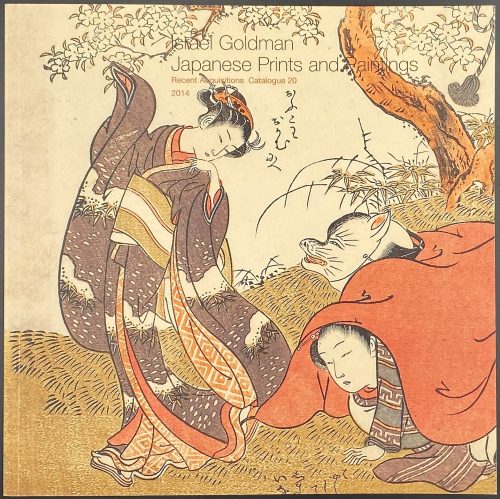 Softcover, pictorial wrappers, square 21 x 21 cm, 40 leaves, unpaginated, with illustrations in colour, 77 entries, with price list laid in; limited edition of 700 copies. Contributor: Israel Goldman Prints in this collection:
Softcover, pictorial wrappers, square 21 x 21 cm, 40 leaves, unpaginated, with illustrations in colour, 77 entries, with price list laid in; limited edition of 700 copies. Contributor: Israel Goldman Prints in this collection:![Isoda Koryūsai . Prosperous Flowers of the Elegant Twelve Seasons: young couple making love while older man sleeps. [Shunga]. 1773](http://varshavskycollection.com/wp-content/uploads/2020/12/SVJP200039.2015-400x288.jpeg)
SVJP-0039.2015: Isoda Koryūsai. Kikuzuki (the ninth month) from the series Furyu juniki no eiga (Prosperous flowers of the elegant twelve months) / Chuban, early 1770s; #7 in the catalogue.
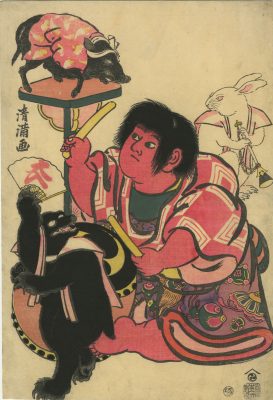
SVJP-0180.2014: Torii Kiyomitsu II. Kintaro with a boar, rabbit, and tanuki / Oban, c. 1805; # 15 in the catalogue.
-
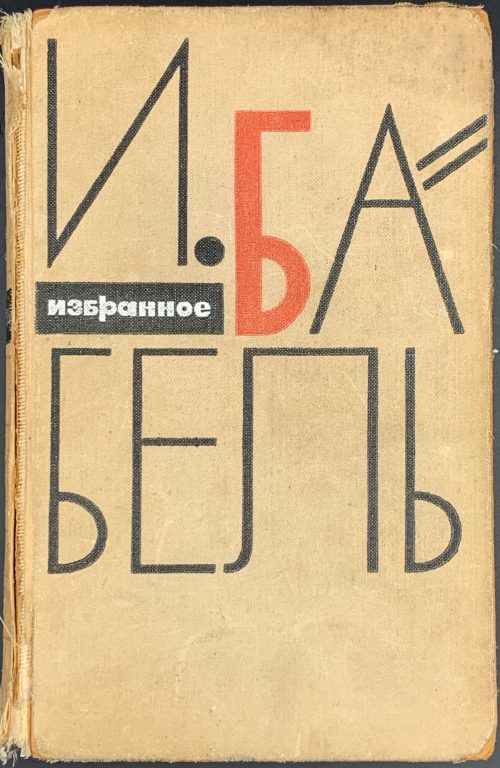 Description: one volume, 20.7 x 13.3 cm, bound in cream cloth with red and black lettering to front cover and spine, author’s photographic portrait frontispiece. Title-page (black and red): ИЗБРАННОЕ (vertical, red) | И. БАБЕЛЬ | {publisher’s device “ИХЛ”} | Издательство | «ХУДОЖЕСТВЕННАЯ ЛИТЕРАТУРА» | Москва | 1966 || Contents: Конармия; Одесские рассказы; Рассказы; Воспоминания; Пьесы; Статьи, выступления; Письма; Комментарии. Imprint: Вступительная статья | Л. ПОЛЯК | Комментарии | Е. КРАСНОЩЕКОВОЙ | Оформление художника | Ю. БОЯРСКОГО | 7–3–2 / 57–66 || Pagination :[2] 3-493 [494] [2]; total 496 pages, ils. Collation: 8vo; [1]-318; total 248 leaves plus author’s photographic portrait frontispiece. Contributors: Исаак Эммануилович Бабель [Isaac Babel] (Russian-Jewish, 1894 – 1940) – author. Лидия Моисеевна Поляк (Russian-Jewish, 1899 – 1992) – author, foreword. Елена Александровна Краснощекова (Russian-Jewish, b. 1934) (see Александр Михайлович Краснощёков) – author, commentary. Юлий Александрович Боярский (Russian, 1924 – 2009) – artist.
Description: one volume, 20.7 x 13.3 cm, bound in cream cloth with red and black lettering to front cover and spine, author’s photographic portrait frontispiece. Title-page (black and red): ИЗБРАННОЕ (vertical, red) | И. БАБЕЛЬ | {publisher’s device “ИХЛ”} | Издательство | «ХУДОЖЕСТВЕННАЯ ЛИТЕРАТУРА» | Москва | 1966 || Contents: Конармия; Одесские рассказы; Рассказы; Воспоминания; Пьесы; Статьи, выступления; Письма; Комментарии. Imprint: Вступительная статья | Л. ПОЛЯК | Комментарии | Е. КРАСНОЩЕКОВОЙ | Оформление художника | Ю. БОЯРСКОГО | 7–3–2 / 57–66 || Pagination :[2] 3-493 [494] [2]; total 496 pages, ils. Collation: 8vo; [1]-318; total 248 leaves plus author’s photographic portrait frontispiece. Contributors: Исаак Эммануилович Бабель [Isaac Babel] (Russian-Jewish, 1894 – 1940) – author. Лидия Моисеевна Поляк (Russian-Jewish, 1899 – 1992) – author, foreword. Елена Александровна Краснощекова (Russian-Jewish, b. 1934) (see Александр Михайлович Краснощёков) – author, commentary. Юлий Александрович Боярский (Russian, 1924 – 2009) – artist. -
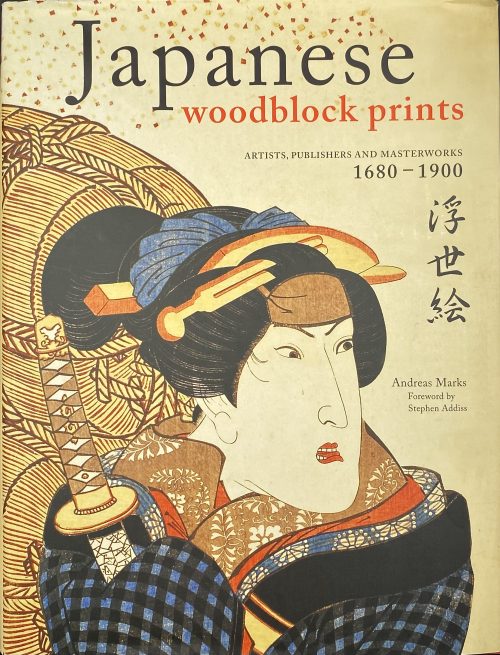 Hardcover, 31 x 24 cm, red paper with black and white lettering to front cover and spine, pictorial endpapers, pictorial dust jacket; pp.: [1-8] 9-336, profusely illustrated in colour. Title-page (black and red): Japanese | woodblock prints | ARTISTS, PUBLISHERS AND MASTERWORKS | 1680 – 1900 | Andreas Marks {|} Foreword by Stephen Addiss | TUTTLE PUBLISHING | Tokyo • Rutland, Vermont • Singapore ||
Hardcover, 31 x 24 cm, red paper with black and white lettering to front cover and spine, pictorial endpapers, pictorial dust jacket; pp.: [1-8] 9-336, profusely illustrated in colour. Title-page (black and red): Japanese | woodblock prints | ARTISTS, PUBLISHERS AND MASTERWORKS | 1680 – 1900 | Andreas Marks {|} Foreword by Stephen Addiss | TUTTLE PUBLISHING | Tokyo • Rutland, Vermont • Singapore || -
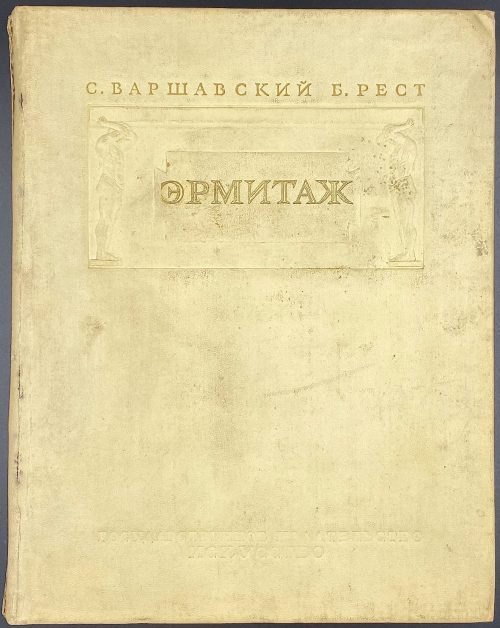 A book about the history and collections of The Hermitage museum in St. Petersburg; hardcover, 22 x 17 cm, collated 8vo, cream buckram blind stamped and lettered in gilt to front cover and design elements and lettering to spine, profusely illustrated. Title-page (in brown rules): С. ВАРШАВСКИЙ • Б. РЕСТ | ЭРМИТАЖ | 1764 – 1939 | ОЧЕРКИ ИЗ ИСТОРИИ | ГОСУДАРСТВЕННОГО ЭРМИТАЖА | под редакцией | академика | И. А. Орбели | {fleuron} || Collation: π2 [1]-158 166; total 128 leaves. Pagination: [2] [2] i-ii [1-4] 5-250 [2], total 256 pages, in-text b/w illustrations. Print run: 5,000 copies. Joseph Orbeli [Иосиф Абгарович Орбели] (Russian-Armenian, 1887 – 1961) – editor. Sergei Petrovich Varshavsky [Сергей Петрович Варшавский] (Jewish-Russian, 1906 – 1980). B. Rest [Б. Рест; Юлий Исаакович Шапиро] (Jewish-Russian, fl. 1940 – 1980).
A book about the history and collections of The Hermitage museum in St. Petersburg; hardcover, 22 x 17 cm, collated 8vo, cream buckram blind stamped and lettered in gilt to front cover and design elements and lettering to spine, profusely illustrated. Title-page (in brown rules): С. ВАРШАВСКИЙ • Б. РЕСТ | ЭРМИТАЖ | 1764 – 1939 | ОЧЕРКИ ИЗ ИСТОРИИ | ГОСУДАРСТВЕННОГО ЭРМИТАЖА | под редакцией | академика | И. А. Орбели | {fleuron} || Collation: π2 [1]-158 166; total 128 leaves. Pagination: [2] [2] i-ii [1-4] 5-250 [2], total 256 pages, in-text b/w illustrations. Print run: 5,000 copies. Joseph Orbeli [Иосиф Абгарович Орбели] (Russian-Armenian, 1887 – 1961) – editor. Sergei Petrovich Varshavsky [Сергей Петрович Варшавский] (Jewish-Russian, 1906 – 1980). B. Rest [Б. Рест; Юлий Исаакович Шапиро] (Jewish-Russian, fl. 1940 – 1980). -
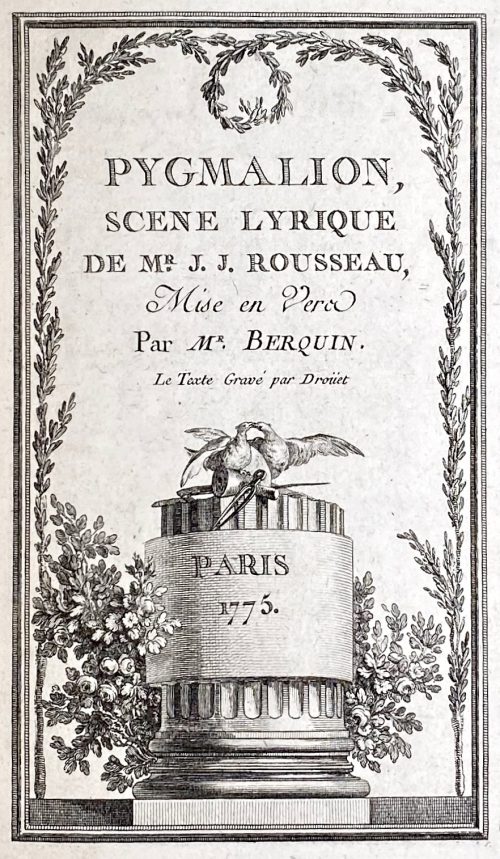 One volume, 22.8 x 15.5 cm, bound in full mottled calf, gilt floral frames to covers, raised bands and gilt fleurons to spine, printed on laid paper. Regarding Pygmalion, scène lyrique see: Wekipedia. Collation: Free endpaper and two blank flyleaves, [2] engraved title, [2] préface, 1-18 (Pygmalion), [2] f.t.p., [1] 2-8 (Idylle), two blank flyleaves and free endpaper; 20 leaves total, adorned with 7 headpieces and 1 tailpiece engraved by Nicolas de Launay, Nicolas Ponce and Charles Etienne Gaucher after Jean Michel Moreau the Younger and Clément Pierre Marillier; text engraved by Droüet. Title-page: PYGMALION, | SCENE LYRIQUE | DE MR. J. J. ROUSSEAU, | Mise en Vers | par MR. Berquin. | Le Text Gravé par Droüet | PARIS | 1775. || (on a column under two kissing doves and sculptor’s tools). Faux t.p.: IDYLLE | Par MR. Berquin. | — | Eructavit cor meum verbum bonum ; | dico ego opera mea regi. | Psalm. 44. | — || (in rules). Catalogue raisonné: Cohen-DeRicci 141 ; Lewine 55. Ref.: MFA (Boston); MET (NY); Yale University Library. Contributors: Artists: Jean-Michel Moreau le Jeune (French, 1741–1814) Clément Pierre Marillier (French, 1740–1808) Engravers: Nicolas Delaunay (French, 1739–1792) Charles-Étienne Gaucher (French, 1741–1804) Nicholas Ponce (French, 1746–1831) Droüet (French, 18th century) Authors: Arnaud Berquin (French, 1747–1791) Jean-Jacques Rousseau (French, 1712–1778)
One volume, 22.8 x 15.5 cm, bound in full mottled calf, gilt floral frames to covers, raised bands and gilt fleurons to spine, printed on laid paper. Regarding Pygmalion, scène lyrique see: Wekipedia. Collation: Free endpaper and two blank flyleaves, [2] engraved title, [2] préface, 1-18 (Pygmalion), [2] f.t.p., [1] 2-8 (Idylle), two blank flyleaves and free endpaper; 20 leaves total, adorned with 7 headpieces and 1 tailpiece engraved by Nicolas de Launay, Nicolas Ponce and Charles Etienne Gaucher after Jean Michel Moreau the Younger and Clément Pierre Marillier; text engraved by Droüet. Title-page: PYGMALION, | SCENE LYRIQUE | DE MR. J. J. ROUSSEAU, | Mise en Vers | par MR. Berquin. | Le Text Gravé par Droüet | PARIS | 1775. || (on a column under two kissing doves and sculptor’s tools). Faux t.p.: IDYLLE | Par MR. Berquin. | — | Eructavit cor meum verbum bonum ; | dico ego opera mea regi. | Psalm. 44. | — || (in rules). Catalogue raisonné: Cohen-DeRicci 141 ; Lewine 55. Ref.: MFA (Boston); MET (NY); Yale University Library. Contributors: Artists: Jean-Michel Moreau le Jeune (French, 1741–1814) Clément Pierre Marillier (French, 1740–1808) Engravers: Nicolas Delaunay (French, 1739–1792) Charles-Étienne Gaucher (French, 1741–1804) Nicholas Ponce (French, 1746–1831) Droüet (French, 18th century) Authors: Arnaud Berquin (French, 1747–1791) Jean-Jacques Rousseau (French, 1712–1778) -
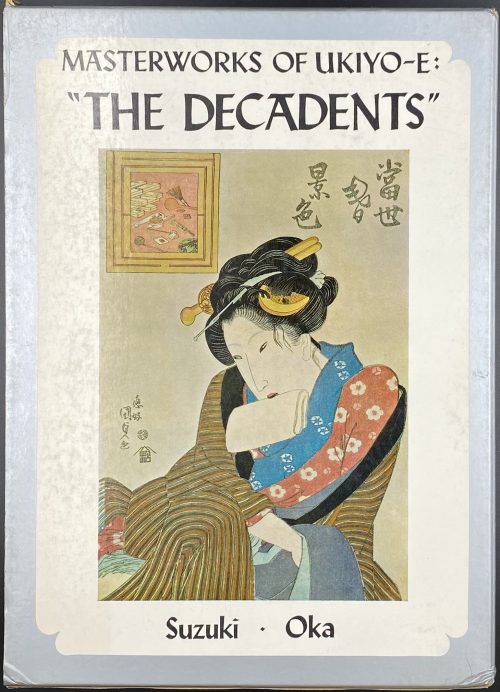 Description: Hardcover 26.5 x 19 cm, grey cloth, red lettering in kanji over black stripe to front, lettering to spine, tan endpapers, pictorial slipcase 27 x 19.5 cm; pp.: [1-6] 7-95 [96], pasted frontispiece and 79 colour illustrations with captions, within a collation. Series Masterworks of ukiyo-e, №8. ISBN: 9780870110986; 0870110985. Ref.: Worldcat Title-page (in frame): MASTERWORKS OF UKIYO-E | "THE DECADENTS” | by Jūzō Suzuki and Isaburō Oka | translation by John Bester | {publisher’s device} | KODANSHA INTERNATIONAL LTD. | Tokyo, Japan & Palo-Alto, Calif., U.S.A. || (Vertical text in kanji to the right, between rules). Artists: Utagawa Kunisada (Japanese [歌川 国貞], 1786 – 1865); Utagawa Kuniyoshi (Japanese [歌川 国芳], 1798 – 1861); Keisai Eisen [Japanese [渓斎 英泉], 1790 – 1848). Contributors: Jūzō Suzuki [鈴木重三] (Japanese, 1919 – 2010) – author. Isaburō Oka [岡畏三郎] (Japanese, 1914 –2010) – author. John Bester (British, 1927 – 2010) – translator Kunisada's fan print in this collection (exactly the same copy) [SVJP-0380.2022]:
Description: Hardcover 26.5 x 19 cm, grey cloth, red lettering in kanji over black stripe to front, lettering to spine, tan endpapers, pictorial slipcase 27 x 19.5 cm; pp.: [1-6] 7-95 [96], pasted frontispiece and 79 colour illustrations with captions, within a collation. Series Masterworks of ukiyo-e, №8. ISBN: 9780870110986; 0870110985. Ref.: Worldcat Title-page (in frame): MASTERWORKS OF UKIYO-E | "THE DECADENTS” | by Jūzō Suzuki and Isaburō Oka | translation by John Bester | {publisher’s device} | KODANSHA INTERNATIONAL LTD. | Tokyo, Japan & Palo-Alto, Calif., U.S.A. || (Vertical text in kanji to the right, between rules). Artists: Utagawa Kunisada (Japanese [歌川 国貞], 1786 – 1865); Utagawa Kuniyoshi (Japanese [歌川 国芳], 1798 – 1861); Keisai Eisen [Japanese [渓斎 英泉], 1790 – 1848). Contributors: Jūzō Suzuki [鈴木重三] (Japanese, 1919 – 2010) – author. Isaburō Oka [岡畏三郎] (Japanese, 1914 –2010) – author. John Bester (British, 1927 – 2010) – translator Kunisada's fan print in this collection (exactly the same copy) [SVJP-0380.2022]:

-
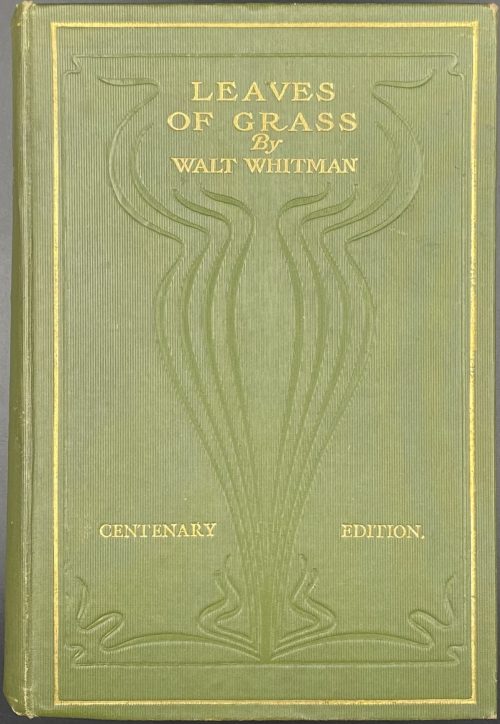 Hardcover, 21.5 x 15 cm, green buckram with gilt border and gilt lettering to front board and spine, blind decorated in art nouveau style, T.E.G. Pagination: [26] 1-294, [4] 1-323 [324], [4] 1-255 [256] [4]; total 912 pages and photo portrait frontispiece. Title-page: THREE VOLUMES IN ONE | LEAVES OF GRASS| WALT WHITMAN | ISSUED UNDER THE | EDITORIAL SUPERVISION OF HIS | LITERARY EXECUTORS, RICHARD MAURICE | BUCKE, THOMAS B. HARNED, AND | HORACE L. TRAUBEL | {device} | D. APPLETON AND COMPANY | New York […] London || For the Russian translation, see LIB-3103.2022 Уолт Уитмен. Листья травы / Пер. с англ. Вступ. статьи К. Чуковского и М. Медельсона. — М.: Государственное издательство художественной литературы, 1955. Contributors: Walter [Walt] Whitman (American, 1819 – 1892) Richard Maurice Bucke (Canadian, 1837 – 1902) Thomas Biggs Harned (American, 1851 – 1921) Horace Logo Traubel (American, 1858 – 1919)
Hardcover, 21.5 x 15 cm, green buckram with gilt border and gilt lettering to front board and spine, blind decorated in art nouveau style, T.E.G. Pagination: [26] 1-294, [4] 1-323 [324], [4] 1-255 [256] [4]; total 912 pages and photo portrait frontispiece. Title-page: THREE VOLUMES IN ONE | LEAVES OF GRASS| WALT WHITMAN | ISSUED UNDER THE | EDITORIAL SUPERVISION OF HIS | LITERARY EXECUTORS, RICHARD MAURICE | BUCKE, THOMAS B. HARNED, AND | HORACE L. TRAUBEL | {device} | D. APPLETON AND COMPANY | New York […] London || For the Russian translation, see LIB-3103.2022 Уолт Уитмен. Листья травы / Пер. с англ. Вступ. статьи К. Чуковского и М. Медельсона. — М.: Государственное издательство художественной литературы, 1955. Contributors: Walter [Walt] Whitman (American, 1819 – 1892) Richard Maurice Bucke (Canadian, 1837 – 1902) Thomas Biggs Harned (American, 1851 – 1921) Horace Logo Traubel (American, 1858 – 1919) -
 Kabuki actor Arashi Kichisaburō III [嵐吉三郎] as Sarushima Sōta [猿島惣太] in the play Hanamo Yoshida Iwao no Matsuwaka [花吉田岩尾松若] staged at Ichimura-za (市村座), theatre in Edo. Artist: Utagawa Kunisada, a.k.a. Toyokuni III (Japanese, 1786 – 1865) [歌川 国貞]. Publisher: Kojimaya Jūbei (Japanese, 1797-1869), seal: Hanmoto, Jū [板元, 十] (Marks 19-043 | 264c. Date seal and double nanushi censor seals Mera & Watanabe – 3rd month of Kaei 6 (1853). Signed: Toyokuni ga [豊国 画] in a red toshidama cartouche. Media: Fan print (uchiwa-e), 223 x 294 mm. Kabuki actor Arashi Kichisaburō III [嵐吉三郎] (Japanese, 1810 – 1864); other names: Arashi Daizaburō III, Arashi Kitsusaburō III Ref.: Art shop Ezoshi Ukiyoe new collection news, vol. 66, 2023.1 (Jan) # 30, p.8.
Kabuki actor Arashi Kichisaburō III [嵐吉三郎] as Sarushima Sōta [猿島惣太] in the play Hanamo Yoshida Iwao no Matsuwaka [花吉田岩尾松若] staged at Ichimura-za (市村座), theatre in Edo. Artist: Utagawa Kunisada, a.k.a. Toyokuni III (Japanese, 1786 – 1865) [歌川 国貞]. Publisher: Kojimaya Jūbei (Japanese, 1797-1869), seal: Hanmoto, Jū [板元, 十] (Marks 19-043 | 264c. Date seal and double nanushi censor seals Mera & Watanabe – 3rd month of Kaei 6 (1853). Signed: Toyokuni ga [豊国 画] in a red toshidama cartouche. Media: Fan print (uchiwa-e), 223 x 294 mm. Kabuki actor Arashi Kichisaburō III [嵐吉三郎] (Japanese, 1810 – 1864); other names: Arashi Daizaburō III, Arashi Kitsusaburō III Ref.: Art shop Ezoshi Ukiyoe new collection news, vol. 66, 2023.1 (Jan) # 30, p.8. -
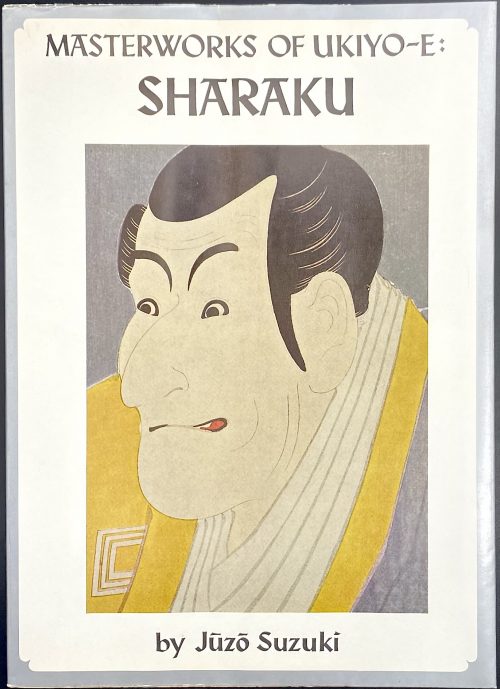 Paperback volume, 25.8 x 18.6 cm, brown embossed wrappers with framed Japanese characters along the outer margin, pictorial dust jacket with series design (black lettering and vignette in silver border to wrappers, black lettering on silver to spine); pp: [1-6]: h.t./frontis. (colour plate pasted in), t.p./imprint, contents/blank), 7-32 text, 33-96 (59 plates w/captions). Title-page (in frame): MASTERWORKS OF UKIYO-E | SHARAKU | by Jūzō Suzuki | Translated by John Bester | {publisher’s device} | KODANSHA INTERNATIONAL LTD. | Tokyo, Japan & Palo-Alto, Calif., U.S.A | {vertical between rules 写楽} || Series: Masterworks of ukiyo-e, № 2. Contributors: Jūzō Suzuki [鈴木 重三] (Japanese, 1919 – 2010) – author. John Bester (British, 1927 – 2010) – translator. Tōshūsai Sharaku [東洲斎 写楽] (Japanese, fl. 1794 – 1795) – artist.
Paperback volume, 25.8 x 18.6 cm, brown embossed wrappers with framed Japanese characters along the outer margin, pictorial dust jacket with series design (black lettering and vignette in silver border to wrappers, black lettering on silver to spine); pp: [1-6]: h.t./frontis. (colour plate pasted in), t.p./imprint, contents/blank), 7-32 text, 33-96 (59 plates w/captions). Title-page (in frame): MASTERWORKS OF UKIYO-E | SHARAKU | by Jūzō Suzuki | Translated by John Bester | {publisher’s device} | KODANSHA INTERNATIONAL LTD. | Tokyo, Japan & Palo-Alto, Calif., U.S.A | {vertical between rules 写楽} || Series: Masterworks of ukiyo-e, № 2. Contributors: Jūzō Suzuki [鈴木 重三] (Japanese, 1919 – 2010) – author. John Bester (British, 1927 – 2010) – translator. Tōshūsai Sharaku [東洲斎 写楽] (Japanese, fl. 1794 – 1795) – artist. -
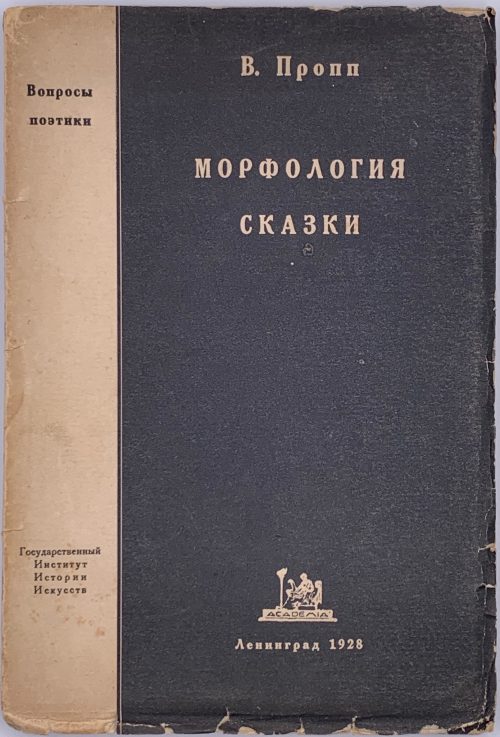 Paperback, 21.3 x 14.5 cm, publisher’s grey and black wrappers with black and grey lettering, respectively; pp. [1-4] 5-151 [1], 152 pages total; collated 8vo: 1-98 104, 76 leaves total. Title-page: В. ПРОПП | МОРФОЛОГИЯ СКАЗКИ | «ACADEMIA» | ЛЕНИНГРАД | 1928 || Frontispiece: ГОСУДАРСТВЕННЫЙ ИНСТИТУТ ИСТОРИИ ИСКУССТВ | ВОПРОСЫ ПОЭТИКИ | НЕПЕРИОДИЧЕСКАЯ СЕРИЯ, ИЗДАВАЕМАЯ | ОТДЕЛОМ СЛОВЕСНЫХ ИСКУССТВ | ВЫПУСК XII | «ACADEMIA» | ЛЕНИНГРАД | 1928 || English title: [LIB-1615.2018] V. Propp. Morphology of the Folktale. — Austin: University of Texas Press, 1979. Print run: 1,600 copies. Catalogue raisonné: Крылов-Кичатова № 328, p. 199. Contributors: Владимир Яковлевич Пропп [Vladimir Propp] (Russian, 1895 – 1970) See also [LIB-1710.2019] (circulation copy) В. Я. Пропп. Исторические корни волшебной сказки (2-е изд.) — Л.: Изд-во ЛГУ, 1986 and (first edition) [LIB-3184.2023] В. Я. Пропп. Исторические корни волшебной сказки. — Л.: Изд-во Ленинградского ун-та, 1946.
Paperback, 21.3 x 14.5 cm, publisher’s grey and black wrappers with black and grey lettering, respectively; pp. [1-4] 5-151 [1], 152 pages total; collated 8vo: 1-98 104, 76 leaves total. Title-page: В. ПРОПП | МОРФОЛОГИЯ СКАЗКИ | «ACADEMIA» | ЛЕНИНГРАД | 1928 || Frontispiece: ГОСУДАРСТВЕННЫЙ ИНСТИТУТ ИСТОРИИ ИСКУССТВ | ВОПРОСЫ ПОЭТИКИ | НЕПЕРИОДИЧЕСКАЯ СЕРИЯ, ИЗДАВАЕМАЯ | ОТДЕЛОМ СЛОВЕСНЫХ ИСКУССТВ | ВЫПУСК XII | «ACADEMIA» | ЛЕНИНГРАД | 1928 || English title: [LIB-1615.2018] V. Propp. Morphology of the Folktale. — Austin: University of Texas Press, 1979. Print run: 1,600 copies. Catalogue raisonné: Крылов-Кичатова № 328, p. 199. Contributors: Владимир Яковлевич Пропп [Vladimir Propp] (Russian, 1895 – 1970) See also [LIB-1710.2019] (circulation copy) В. Я. Пропп. Исторические корни волшебной сказки (2-е изд.) — Л.: Изд-во ЛГУ, 1986 and (first edition) [LIB-3184.2023] В. Я. Пропп. Исторические корни волшебной сказки. — Л.: Изд-во Ленинградского ун-та, 1946. -
![Э. Лиссагарэ. История Парижской Коммуны в 1871 году / С французского. Полный перевод под редакцией В. Базарова. — С.-Петербург. 1906. (Дешевая библиотека товарищества "Знание", № 274). — pp.:[4] [1] 2-524. [Проспер Оливье Лиссагарэ].](https://varshavskycollection.com/wp-content/uploads/2021/02/LIB-1158.2016-d-500x729.jpeg) Hardcover volume, collated in-8o, 21.1 x 14.9 cm, bound in half black polished morocco over green buckram boards, gilt lettering in rules to flat spine, brown diaper over cream endpapers, red ink oval library stamp in Estonian to t.p. «AJALOOMUUSEUM RAAMATUKOGU» (history museum library); pp.: [4] [1] 2-524, total 528 pages; collation π2 1-328 336, total 264 leaves. Title-page: ДЕШЕВАЯ БИБЛIОТЕКА ТОВАРИЩЕСТВА "ЗНАНIЕ". | № 274. | Э. Лиссагарэ. | ИСТОРIЯ ПАРИЖСКОЙ КОММУНЫ | въ 1871 г. | Съ французскаго. Полный переводъ | подъ редакцiей В. Базарова.| С.-ПЕТЕРБУРГЪ | 1906. || Original title: Prosper-Olivier Lissagaray. Histoire de la Commune de 1871. — Paris: E. Dentu, 1876. English translation by Eleanor Marx Aveling: [LIB-1110.2016] Prosper-Olivier Lissagaray. History of the Commune of 1871. — London: Reeves and Turner, 1886. Contributors: Hippolyte Prosper-Olivier Lissagaray (French, 1838 – 1901) – author. Владимир Александрович Базаров [Руднев, Vladimir Bazarov] (Russian, 1874 – 1939) – translator.
Hardcover volume, collated in-8o, 21.1 x 14.9 cm, bound in half black polished morocco over green buckram boards, gilt lettering in rules to flat spine, brown diaper over cream endpapers, red ink oval library stamp in Estonian to t.p. «AJALOOMUUSEUM RAAMATUKOGU» (history museum library); pp.: [4] [1] 2-524, total 528 pages; collation π2 1-328 336, total 264 leaves. Title-page: ДЕШЕВАЯ БИБЛIОТЕКА ТОВАРИЩЕСТВА "ЗНАНIЕ". | № 274. | Э. Лиссагарэ. | ИСТОРIЯ ПАРИЖСКОЙ КОММУНЫ | въ 1871 г. | Съ французскаго. Полный переводъ | подъ редакцiей В. Базарова.| С.-ПЕТЕРБУРГЪ | 1906. || Original title: Prosper-Olivier Lissagaray. Histoire de la Commune de 1871. — Paris: E. Dentu, 1876. English translation by Eleanor Marx Aveling: [LIB-1110.2016] Prosper-Olivier Lissagaray. History of the Commune of 1871. — London: Reeves and Turner, 1886. Contributors: Hippolyte Prosper-Olivier Lissagaray (French, 1838 – 1901) – author. Владимир Александрович Базаров [Руднев, Vladimir Bazarov] (Russian, 1874 – 1939) – translator. -
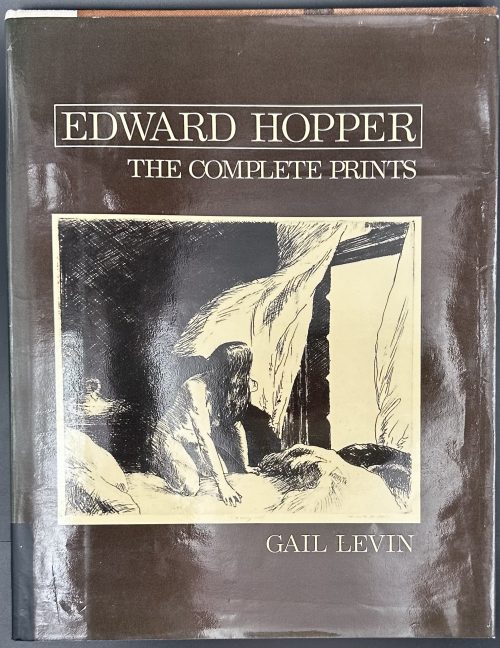 Hardcover volume, 28.6 x 22.4 cm, tan cloth over brown cloth boards, black lettering to spine, blind-stamped lettering in frame to front, in a black pictorial dust jacket, price unclipped; pp.: [1-ix] x-xi [xii blank], [1-4] 5-36 [4], 64 pages with 109 b/w plates, 12 pages with chronology, bibliography, credits; total 128 pp. Title-page: EDWARD HOPPER (in frame)| THE COMPLETE PRINTS | GAIL LEVIN | W • W • NORTON & COMPANY • NEW YORK • LONDON | IN ASSOCIATION WITH THE | WHITNEY MUSEUM OF AMERICAN ART || Contributors: Gail Levin (American, b. 1948) – author. Edward Hopper (American, 1882 – 1967) – artist. W. W. Norton & Company (f. 1923) – publisher. Whitney Museum of American Art (NY) – publisher.
Hardcover volume, 28.6 x 22.4 cm, tan cloth over brown cloth boards, black lettering to spine, blind-stamped lettering in frame to front, in a black pictorial dust jacket, price unclipped; pp.: [1-ix] x-xi [xii blank], [1-4] 5-36 [4], 64 pages with 109 b/w plates, 12 pages with chronology, bibliography, credits; total 128 pp. Title-page: EDWARD HOPPER (in frame)| THE COMPLETE PRINTS | GAIL LEVIN | W • W • NORTON & COMPANY • NEW YORK • LONDON | IN ASSOCIATION WITH THE | WHITNEY MUSEUM OF AMERICAN ART || Contributors: Gail Levin (American, b. 1948) – author. Edward Hopper (American, 1882 – 1967) – artist. W. W. Norton & Company (f. 1923) – publisher. Whitney Museum of American Art (NY) – publisher. -
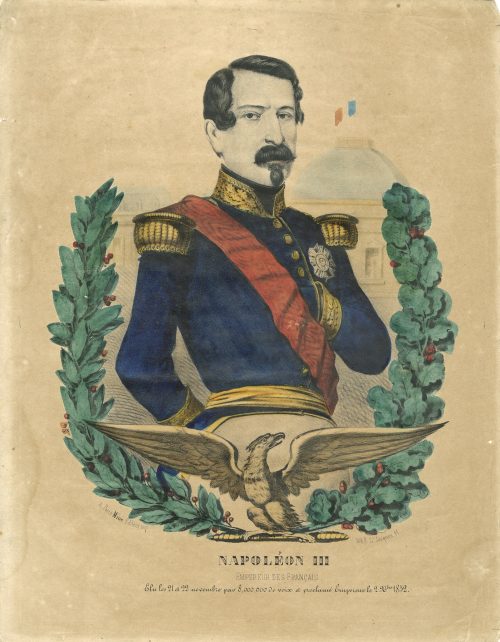 Hand-coloured lithography on wove paper, 380 x 298 mm; black ink stamp “4912” to reverse. On stone left: "A, Paris Miné Éditeur, imp.;" right: "Lith. R. St. Jacques. 41." Bottom center: "Napoléon III"; below: "EMPEREUR DES FRANÇAIS", under: "Élu les 21 el 22 novembre par 8,000,000 de voix et proclamé Empereur le 2 Xbre 1852." Printer/publisher: Miné, éditeur, imprimeur en lithographie, Rue Saint-Jacques, 41. Napoleon III [Charles-Louis Napoléon Bonaparte] (French, 1808 – 1873)
Hand-coloured lithography on wove paper, 380 x 298 mm; black ink stamp “4912” to reverse. On stone left: "A, Paris Miné Éditeur, imp.;" right: "Lith. R. St. Jacques. 41." Bottom center: "Napoléon III"; below: "EMPEREUR DES FRANÇAIS", under: "Élu les 21 el 22 novembre par 8,000,000 de voix et proclamé Empereur le 2 Xbre 1852." Printer/publisher: Miné, éditeur, imprimeur en lithographie, Rue Saint-Jacques, 41. Napoleon III [Charles-Louis Napoléon Bonaparte] (French, 1808 – 1873) -
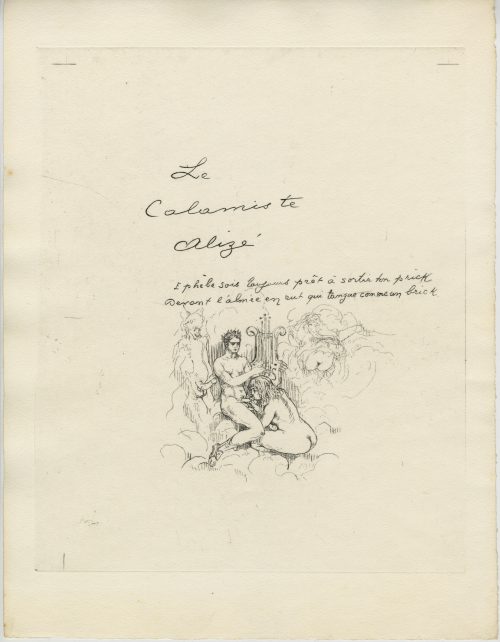 Thirteen unnumbered loose leaves 323 x 249 mm, watermarked BFK Rives, with manuscript text and vignettes produced by etching or, more likely, drypoint (see microphoto), incl. title-page, one full-page illustration and two leaves of text only; versos blank. Some leaves have registration marks. The set is housed in a cream French flapped folder (chemise) without lettering; the seller’s description is pasted to the front cover verso, glassine dust cover. Seller’s description: Cette édition in-folio du recueil de poèmes de Louis de Gonzague Frick, inconnue de Jean-Pierre Dutel, qui « a été tirée à 50 exemplaires (...) est certainement la plus rare (et a été) publiée après 1940 sur vélin (BFK) Rives » (cf. Ader, 3 mars 2020, n°155). Exemplaire « de passe », sans justificatif, complet des 13 planches avec 11 eaux-fortes, dont une à pleine page, d'Auguste Brouet. Ref.: According to honesterotica, the first edition was published in 1938 in 65 copies: "The pink Ingres paper and the loose-leaf format tied with a red ribbon". Another source states: "Le tirage a été effectué avec marges, sur papier vélin BFK Rives au format in-4 (32,5 × 25), les planches mesurant 26,5 × 22 cm. Certains exemplaires sont sur papier blanc - Je remercie le libraire qui a pris la peine de me communiquer ces dernières informations. Pour moi, c'est bien l'édition à 65 qui est l'originale, les deux autres étant des retirages légèrement postérieurs, mais dans le détail desquels le principe de l’œuvre - un manuscrit destiné à quelques amis de l'auteur - a été quelque peu trahi." Contributors: Louis de Gonzague Frick (French, 1883 – 1958) Auguste Brouet (French, 1872 – 1941)
Thirteen unnumbered loose leaves 323 x 249 mm, watermarked BFK Rives, with manuscript text and vignettes produced by etching or, more likely, drypoint (see microphoto), incl. title-page, one full-page illustration and two leaves of text only; versos blank. Some leaves have registration marks. The set is housed in a cream French flapped folder (chemise) without lettering; the seller’s description is pasted to the front cover verso, glassine dust cover. Seller’s description: Cette édition in-folio du recueil de poèmes de Louis de Gonzague Frick, inconnue de Jean-Pierre Dutel, qui « a été tirée à 50 exemplaires (...) est certainement la plus rare (et a été) publiée après 1940 sur vélin (BFK) Rives » (cf. Ader, 3 mars 2020, n°155). Exemplaire « de passe », sans justificatif, complet des 13 planches avec 11 eaux-fortes, dont une à pleine page, d'Auguste Brouet. Ref.: According to honesterotica, the first edition was published in 1938 in 65 copies: "The pink Ingres paper and the loose-leaf format tied with a red ribbon". Another source states: "Le tirage a été effectué avec marges, sur papier vélin BFK Rives au format in-4 (32,5 × 25), les planches mesurant 26,5 × 22 cm. Certains exemplaires sont sur papier blanc - Je remercie le libraire qui a pris la peine de me communiquer ces dernières informations. Pour moi, c'est bien l'édition à 65 qui est l'originale, les deux autres étant des retirages légèrement postérieurs, mais dans le détail desquels le principe de l’œuvre - un manuscrit destiné à quelques amis de l'auteur - a été quelque peu trahi." Contributors: Louis de Gonzague Frick (French, 1883 – 1958) Auguste Brouet (French, 1872 – 1941) -
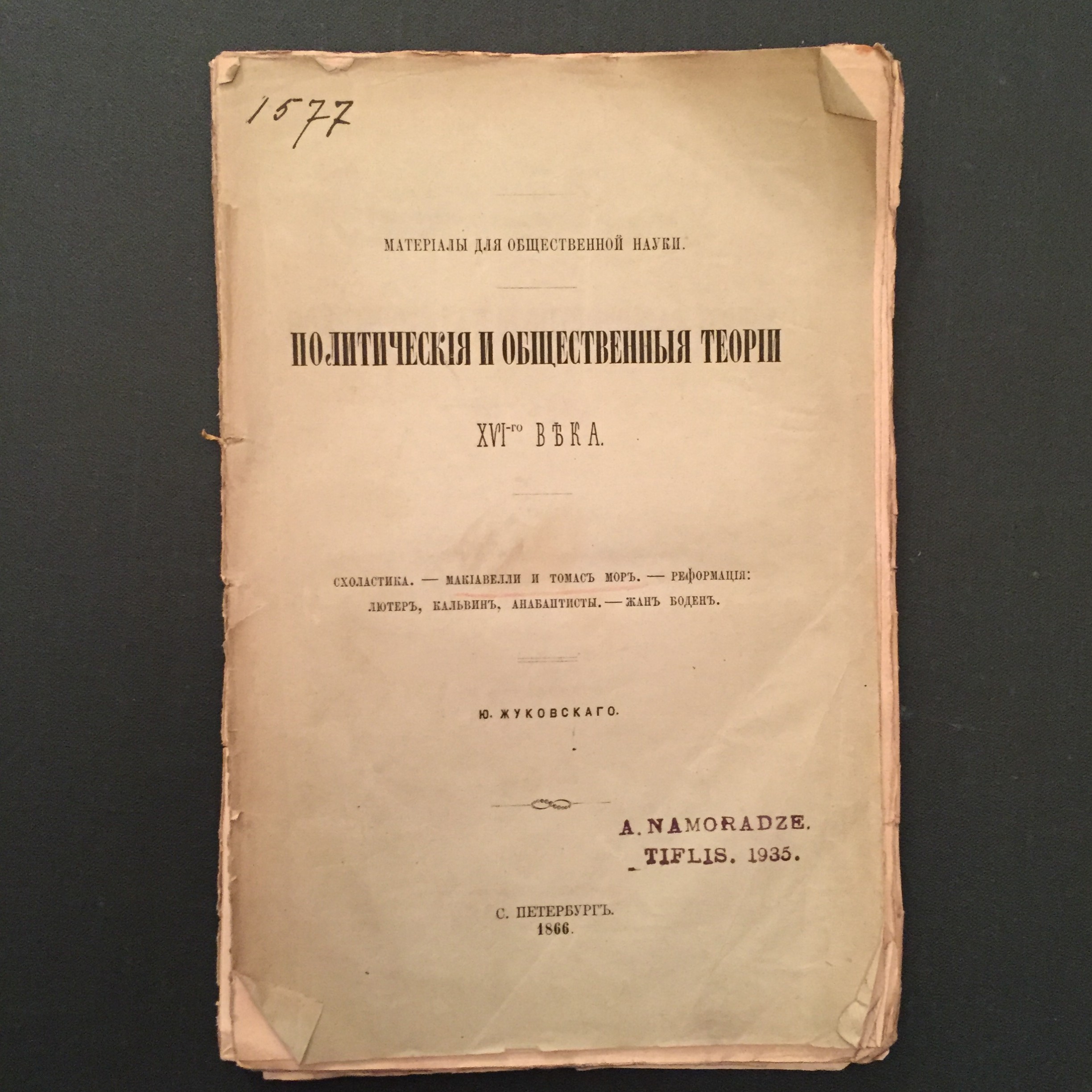
Жуковский Ю. Г. Политические и общественные теории XVI-го века. - С.Петербург, 1866. Типография А. Головачева. // Материалы для общественной науки. - 163 с.
Схоластика.
Макиавелли и Томас Мор.
Реформация: Лютер, Кальвин, анабаптисты.
Жан Боден.
[Штамп на титуле: A. Namoradze, Tiflis. 1935.]
-
 UTAGAWA TOYOKUNI I (1769–1825) Ichikawa Danjūrō VII (Ebizo V) in a shibaraku costume bursting through a paper screen. Surimono. Colour woodblock print: shikishiban, 8⅛ x 7⅛ in. (20.7 x 18.2 cm) Signed: Toyokuni ga Poem signed: Sakuragawa Jihinari Provenance: Sidney C. Ward
UTAGAWA TOYOKUNI I (1769–1825) Ichikawa Danjūrō VII (Ebizo V) in a shibaraku costume bursting through a paper screen. Surimono. Colour woodblock print: shikishiban, 8⅛ x 7⅛ in. (20.7 x 18.2 cm) Signed: Toyokuni ga Poem signed: Sakuragawa Jihinari Provenance: Sidney C. Ward -
 Iron tsuba of slightly elongated round form decorated with design of melon flowers, vines, and leaves in brass flat inlay (hira-zōgan) on both sides. Slightly raised rim (mimi) carved in a way to simulate ring-shaped covering (fukurin). Kozuka hitsu-ana and kogai hitsu-ana both plugged with soft metal (tim or lead). Copper sekigane. Heianjō or Kaga School. Muromachi or Momoyama period, 16th century. Iron, hira-zōgan brass inlay. Round (maru gata) form, diameter 79 mm. Size: 80.3 x 78.4 mm; thickness at seppa-dai: 3.4 mm; at the middle: 3.8 mm; before the rim: 2.4 mm, rim: 2.8 mm. Note on design: though this design resembles family crests with oak and mulberry leaves, I believe it's a melon flower [see Jeanne Allen. Designer's guide to Samurai Patterns. Chronicle Books, San Francisco, 1990, page 114, №130 "Melon Flowers":Note about the distribution of thickness (niku-oki): "this tsuba has toroid features, niku raises from the rim towards the centre but thins once more out when approaching the seppa-dai" [M. Sesko, "Handbook...", p. 48].
Iron tsuba of slightly elongated round form decorated with design of melon flowers, vines, and leaves in brass flat inlay (hira-zōgan) on both sides. Slightly raised rim (mimi) carved in a way to simulate ring-shaped covering (fukurin). Kozuka hitsu-ana and kogai hitsu-ana both plugged with soft metal (tim or lead). Copper sekigane. Heianjō or Kaga School. Muromachi or Momoyama period, 16th century. Iron, hira-zōgan brass inlay. Round (maru gata) form, diameter 79 mm. Size: 80.3 x 78.4 mm; thickness at seppa-dai: 3.4 mm; at the middle: 3.8 mm; before the rim: 2.4 mm, rim: 2.8 mm. Note on design: though this design resembles family crests with oak and mulberry leaves, I believe it's a melon flower [see Jeanne Allen. Designer's guide to Samurai Patterns. Chronicle Books, San Francisco, 1990, page 114, №130 "Melon Flowers":Note about the distribution of thickness (niku-oki): "this tsuba has toroid features, niku raises from the rim towards the centre but thins once more out when approaching the seppa-dai" [M. Sesko, "Handbook...", p. 48].
Jeanne Allen. Designer's guide to Samurai Patterns. Chronicle Books, San Francisco, 1990. Page 114, №130.
-
 Ōnin shinchū ten-zōgan tsuba. Iron tsuba of round form decorated with full moon and bamboo shoot (takenoko) motif executed in openwork (sukashi) and inlaid with four concentric rows of brass dots (ten-zōgan). The innermost row of dots as well as the sukashi openings outlined with the inlaid linear brass wire. Late Muromachi period, 16th century. Diameter: 82.0 mm; Thickness: 2.8 mm Cited from Merrily Baird. Symbols of Japan. Thematic motifs in art and design. Rizzoli international publications, Inc., 2001, p. 72: "In Japanese art, the appearance of bamboo shoots is often without symbolic meaning. In other cases, however, the shoots are emblematic of Moso (Chinese: Meng Tsung/Meng Zong), a paragon of filial piety who dug through snow to find shoots for his mother. ... especially in miniature art forms, let bamboo shoots alone speak for the full story." The full story is this (See THE TWENTY-FOUR PARAGONS OF FILIAL PIETY [ERSHISI XIAO]):
Ōnin shinchū ten-zōgan tsuba. Iron tsuba of round form decorated with full moon and bamboo shoot (takenoko) motif executed in openwork (sukashi) and inlaid with four concentric rows of brass dots (ten-zōgan). The innermost row of dots as well as the sukashi openings outlined with the inlaid linear brass wire. Late Muromachi period, 16th century. Diameter: 82.0 mm; Thickness: 2.8 mm Cited from Merrily Baird. Symbols of Japan. Thematic motifs in art and design. Rizzoli international publications, Inc., 2001, p. 72: "In Japanese art, the appearance of bamboo shoots is often without symbolic meaning. In other cases, however, the shoots are emblematic of Moso (Chinese: Meng Tsung/Meng Zong), a paragon of filial piety who dug through snow to find shoots for his mother. ... especially in miniature art forms, let bamboo shoots alone speak for the full story." The full story is this (See THE TWENTY-FOUR PARAGONS OF FILIAL PIETY [ERSHISI XIAO]):Tears That Brought Bamboo-shoots From the Frozen Earth: Meng Zong Meng Zong lived during the Three Kingdoms Period of China's past. His father died when he was young, and he and his mother struggled to survive. One winter his mother was stricken with a serious illness, and craved some bamboo-shoot broth as medicine. But in the depths of winter, with snow and ice blanketing the ground, where was anyone to find fresh bamboo shoots, shoots that emerge only in the warm months? Nonetheless, Meng Zong, to avoid disappointing his mother, bravely fetched his shovel and went out into the white landscape in search of bamboo shoots. In the thicket he found only frosted leaves and green stalks coated with snowflakes and ice. Look as he might, there were simply no fresh shoots growing in the winter. The thought of his poor mother lying sick on her bed, waiting for bamboo-broth medicine, made his heartache. Uncontrollably, tears began to fall in rivers to the ground beneath the tall, emerald canes. Even now, as his tears flowed down, he kept a light of faith in his heart. If he was truly sincere in his search, perhaps.... Just then Meng Zong nearly tripped and fell over a sharply protruding lump of earth. He quickly knelt down and knocked aside the dirt with his trembling fingers. How uncanny! Underneath his frozen hands he discovered a bed of fresh, tender bamboo shoots! Overjoyed, he gathered up a coatful and carried them back home. The broth that he quickly set stewing in the pot soon cured his mother's illness. The neighbors, hearing the story, exclaimed that it was the strength of his sincere, unselfish, filial resolve that inspired heaven and earth to respond, and to bring up, out of season, the fresh shoots that cured his mother's disease. Before Meng Zong's prayers generated this miracle, it was normally considered impossible for bamboo shoots to grow in the winter. After the nmiracle took place, however, people were able to gather and to eat bamboo shoots all year round. The winter variety that existed hereafter became known as "winter shoots." The villagers were deeply influenced by Meng Zong's courage and devotion. They renamed the spot where the event took place, "Meng Zong's Bamboo Grove". We can now enjoy bamboo sprouts during the winter as well, and as we do so, it is fitting to recollect Meng Zong's outstanding example of filial respect, and reflect on our conduct as sons and daughter of our parents. A verse in his honor says, His teardrops transformed winter at the roots; Up from the ice crept tender bamboo shoots. Instantly, the winter-sprouts matured; Heaven's will: a happy, peaceful world.
-
 Round iron plate of grey colour decorated in low relief (sukidashi-bori) on the face with sea waves (both layered waves, seigaiha, and rough waves, araumi), sago palm (cycas revoluta, sotetsu), presumably orchid leaves (ran) - five of them - hanging from the above, and reeds (ashi), and on the back with waves (seigaiha only), rocks, chrysanthemums (kiku), clove (chori), reed, and presumably orchid leaves - three of them - hanging from the above. The kozuka-hitsu-ana was probably cut later. The plate is lacking the raised rim, typical for the kamakura-bori school. Muromachi period. Dimensions: Height: 76.8 mm, width: 76.1 mm, Thickness at seppa-dai: 3.3 mm, at rim 2.0 mm. Height of nakago-ana: 29 mm. Weight: 82.4 g. NBTHK certificate № 402152: Hozon - "Worthy of preservation". A similar (most probably the same) tsuba is illustrated and described at Butterfield & Butterfield. IMPORTANT JAPANESE SWORDS, SWORD FITTINGS AND ARMOR. Auction Monday, November 19th, 1979. Sale # 3063 under lot № 66. It describes the piece as following: “Kamakura bori work of the Muromachi period. Round thin plate with some small iron bones in the edge. Carved with design of plants (sego palm) rocks, and waves on the face. The back has half of two chrysanthemums, waves, clove, and sego palm leaves. The kozuka-hitsu has been added and later enlarged. A good typical example without the rim most have. Diameter: 7.7 cm., thickness 2.5 mm. Estimated price $100-200":
Round iron plate of grey colour decorated in low relief (sukidashi-bori) on the face with sea waves (both layered waves, seigaiha, and rough waves, araumi), sago palm (cycas revoluta, sotetsu), presumably orchid leaves (ran) - five of them - hanging from the above, and reeds (ashi), and on the back with waves (seigaiha only), rocks, chrysanthemums (kiku), clove (chori), reed, and presumably orchid leaves - three of them - hanging from the above. The kozuka-hitsu-ana was probably cut later. The plate is lacking the raised rim, typical for the kamakura-bori school. Muromachi period. Dimensions: Height: 76.8 mm, width: 76.1 mm, Thickness at seppa-dai: 3.3 mm, at rim 2.0 mm. Height of nakago-ana: 29 mm. Weight: 82.4 g. NBTHK certificate № 402152: Hozon - "Worthy of preservation". A similar (most probably the same) tsuba is illustrated and described at Butterfield & Butterfield. IMPORTANT JAPANESE SWORDS, SWORD FITTINGS AND ARMOR. Auction Monday, November 19th, 1979. Sale # 3063 under lot № 66. It describes the piece as following: “Kamakura bori work of the Muromachi period. Round thin plate with some small iron bones in the edge. Carved with design of plants (sego palm) rocks, and waves on the face. The back has half of two chrysanthemums, waves, clove, and sego palm leaves. The kozuka-hitsu has been added and later enlarged. A good typical example without the rim most have. Diameter: 7.7 cm., thickness 2.5 mm. Estimated price $100-200":
Butterfield & Butterfield, 1979. Sale # 3063, lot № 66.
-
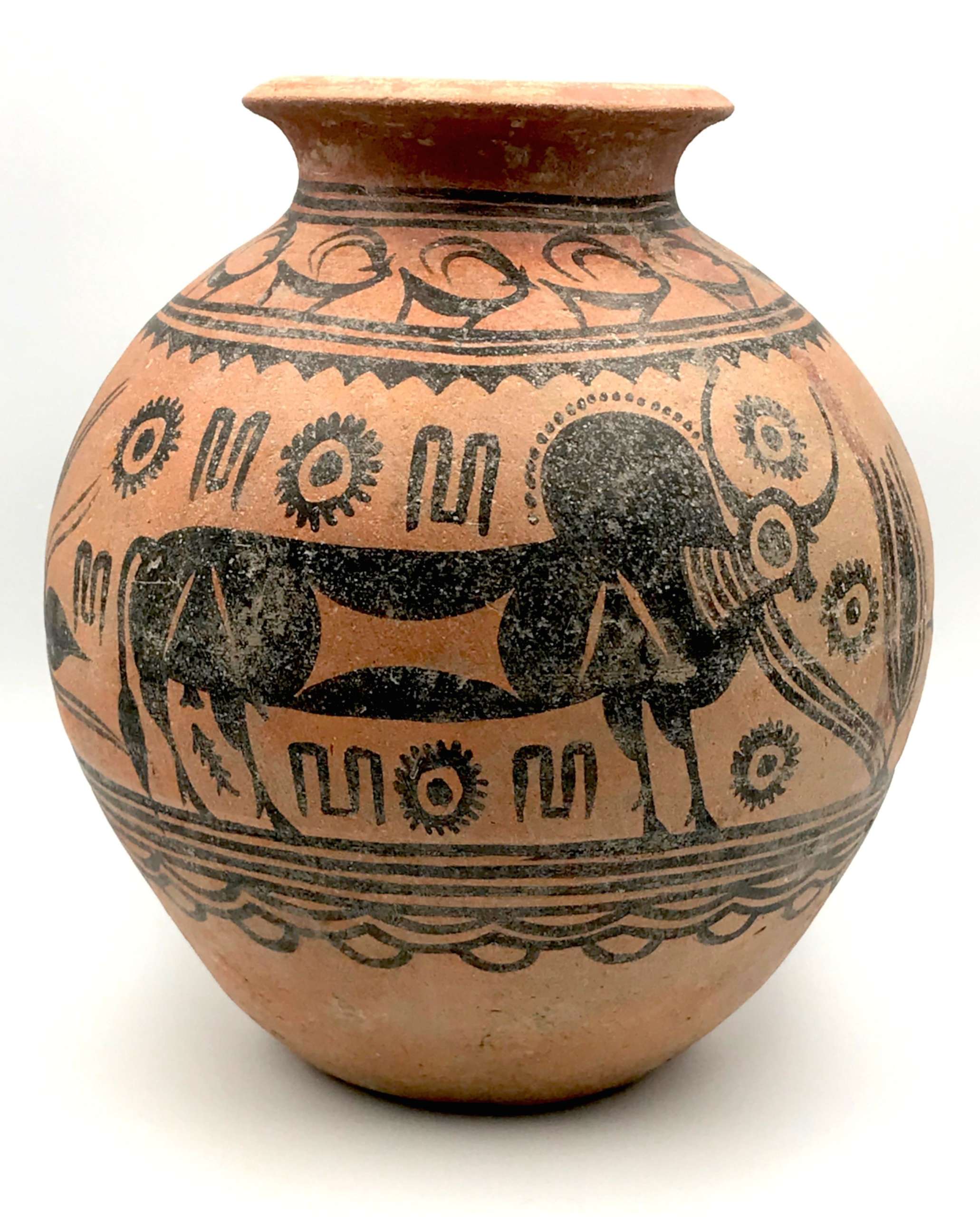 Circa 3300-2000 BC Dimensions: 184 x 165mm. Weight: 708grams
Circa 3300-2000 BC Dimensions: 184 x 165mm. Weight: 708grams -

Iron tsuba of round form with dam-shaped rim (dote-mimi) pierced with hitsu-ana and two udenuki-ana (probably cut later on) decorated in flat inlay (hira-zōgan) with vines and symbols of thunder or lightning (possibly - family crest, mon). Hitsu-ana and nakago-ana with copper sekigane.
Ōnin or Heianjō school, or, possibly Kaga or Umetada school. Momoyama period or earlier (Muromachi), 16th century. Unsigned.Size: 64.5 x 63.8 x 2.2 (center), 4.2 (rim) mm.
Provenance: Lundgren Collection: [Japanese sword-fittings and metalwork in the Lundgren Collection. Published by Otsuka Kogeisha Co., Ltd., Tokyo 1992], №31; The Lundgren Collection of Japanese Swords, Sword Fittings and A Group of Miochin School Metalwork. Christie's Auction: Tuesday, 18 November 1997, London. Sales "GOTO-5881". Christie's, 1997, №2. Lundgren's description at Christie's: Heianjo tsuba. Unsigned. The circular plate decorated in brass hirazogan with flowers, plants and symbols of thunder, dote mimi and udenuki ana, late Muromachi period (16th century). Tokyo 1992 description: Sword guard with design of flowering plants and frets in inlay. Unsigned. Heianjo inlay school. 6.35 x 6.3 cm, thickness of rim 0.40 cm. Iron. Flat brass inlay. Muromachi-Momoyama Period, 16th century. Provenance: The Second John Harding. A somewhat look-a-like pieces can be found in various catalogues. The one in Naunton Collection, №172, is signed: Umetada of Yamashiro: "Iron, small, almost circular, with raised oval rim, inlaid all over with leaves and scrolls in brass hirazōgan." -
 Iron tsuba of round form decorated with design of moon, stars, cloud, snowflake, gorintō, and Genji-mon in negative openwork (in-sukashi). Raised tubular rim (dote-mimi). Deep black patina, traces of lacquer. Naka-daka type of plate (thicker in center, getting thiner towards the rim). Visible gap between the rim and the plate. Dimensions: Height: 91.7 mm; Width: 90.8 mm; Thickness at seppa-dai: 2.5 mm, plate before rim: 2.2 mm, of the rim: 5.6 mm. At least Mid Muromachi period, 15th century, but possibly earlier. In 'Silver Book', commenting tsuba №34 Sasano writes: "The technique used to create the rim is the same used for the peak (koshimaki) of helmets (kabuto) during the Kamakura and Nanbokucho periods." On the other hand, the abundance of sukashi elements points towards later times, perhaps late Muromachi or even Momoyama period. "Gorintō is a grave stone composed of five pieces, piled on one the other, representing, from the bottom upward, earth, water, fire, wind, and heaven, respectively" [Nihon Tō Kōza, Volume VI, Part 1. AFU, 1993, p. 6. / LIB-1554]. A romantic description of the piece may look like this: The air is scented (incense symbol); it's a graveyard, marked by gorintō; a winter (snowflake) evening or night (moon, stars); mist is rising from a ravine towards moon. I did not manage to find a katchūshi piece of this design, only a few Kamakura-bori tsuba:
Iron tsuba of round form decorated with design of moon, stars, cloud, snowflake, gorintō, and Genji-mon in negative openwork (in-sukashi). Raised tubular rim (dote-mimi). Deep black patina, traces of lacquer. Naka-daka type of plate (thicker in center, getting thiner towards the rim). Visible gap between the rim and the plate. Dimensions: Height: 91.7 mm; Width: 90.8 mm; Thickness at seppa-dai: 2.5 mm, plate before rim: 2.2 mm, of the rim: 5.6 mm. At least Mid Muromachi period, 15th century, but possibly earlier. In 'Silver Book', commenting tsuba №34 Sasano writes: "The technique used to create the rim is the same used for the peak (koshimaki) of helmets (kabuto) during the Kamakura and Nanbokucho periods." On the other hand, the abundance of sukashi elements points towards later times, perhaps late Muromachi or even Momoyama period. "Gorintō is a grave stone composed of five pieces, piled on one the other, representing, from the bottom upward, earth, water, fire, wind, and heaven, respectively" [Nihon Tō Kōza, Volume VI, Part 1. AFU, 1993, p. 6. / LIB-1554]. A romantic description of the piece may look like this: The air is scented (incense symbol); it's a graveyard, marked by gorintō; a winter (snowflake) evening or night (moon, stars); mist is rising from a ravine towards moon. I did not manage to find a katchūshi piece of this design, only a few Kamakura-bori tsuba:
100 selected tsuba from European collections. Catalogue by Robert Haynes and Robert Burawoy, 1984, page 16, №5.
While the upper tsuba is dated end of Muromachi, the lower is attributed to the 17th century - Momoyama or early Edo period, though the author put this attribution under question. Deciphering of the strangely shaped opening to the left of nakago-ana is sometimes "a conventional scroll", and sometimes - a fern or bracken. I think mine is a cloud or mist, but I don't have any material evidence proving this understanding and came to conclusion by context only. It may easily be a dinosaurs playing ball. The fact that this thing always accompanies the Genji-mon, or incense symbol, it may be a scent itself.
Japanese Sword Fittings. Collection of G.H. Naunton, Esq., by Henri L. Joly, - 1912; №9.
-
 Iron tsuba of round form decorated with eight roundels – circular emblems of flowers and/or family crests (mon) made of cast brass, pierced and chiselled in kebori, and with flat brass inlay (hira-zōgan) of vines or leaves all over the plate. Both hitsu-ana trimmed with brass. Nakago-ana of trapezoidal form. A distinctive character of this tsuba is a mon at 6 hours depicting tomoe (comma). Yoshirō school (Kaga-Yoshirō). Attributed to Koike Yoshirō Naomasa himself. Unsigned. The Momoyama or early Edo period, end of the 16th to the first half of the 17th century (1574-1650). Size: Diameter 82.0 mm, thickness 3.8 mm at seppa-dai, 3.4 mm at rim.
Iron tsuba of round form decorated with eight roundels – circular emblems of flowers and/or family crests (mon) made of cast brass, pierced and chiselled in kebori, and with flat brass inlay (hira-zōgan) of vines or leaves all over the plate. Both hitsu-ana trimmed with brass. Nakago-ana of trapezoidal form. A distinctive character of this tsuba is a mon at 6 hours depicting tomoe (comma). Yoshirō school (Kaga-Yoshirō). Attributed to Koike Yoshirō Naomasa himself. Unsigned. The Momoyama or early Edo period, end of the 16th to the first half of the 17th century (1574-1650). Size: Diameter 82.0 mm, thickness 3.8 mm at seppa-dai, 3.4 mm at rim. -
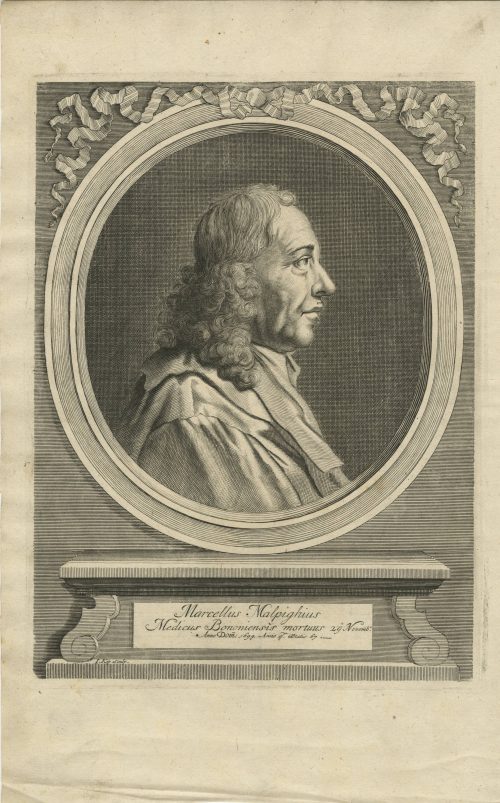
A portrait of Marcello Malpighi from his book Opera posthuma: figuris aeneis illustrata, quibus praefixa est ejusdem vita a seipso scripta, Londini:Churchill, 1697. Inscription: Marcellus Malpighius | Medicus Bononiensis mortuus 29 Novemb. Anno Dom. 1694. Anno aetatis 67. I. Kip. sculp.
Marcello Malpighi (10 March 1628 – 29 November 1694) was an Italian biologist and physician, who is referred to as the "Father of microscopical anatomy, histology, physiology and embryology" [Wikipedia].
From European Journal of Anatomy 22(5):433-439 · September 2018, an article by Sanjib Ghosh and Ashutosh Kumar 'Marcello Malpighi (1628-1694): Pioneer of microscopic anatomy and exponent of the scientific revolution of the 17th Century': Italian anatomist and an eminent scientist who significantly contributed to the advancement of the anatomical sciences in the 17th century. Malpighi was one of the first to use the compound microscope (an instrument designed by Galileo in 1609) and made the most important discovery of his life in 1661 when he identified capillaries as connecting vessels between small arteries and veins in the lungs. Malpighi thus provided the missing link in William Harvey's theory of blood circulation. He made significant contributions in the field of embryology based on his observations on chick embryo, and his efforts provided deep insights into the development of the heart and the nervous system. His communications based on microscopic studies scripted valuable details on the structural organization of organs like the liver, kidney and spleen. He identified the hepatic lobule as the fundamental unit of the liver and noted that bile was being secreted by these lobules and not from the gall bladder (the popular belief then). In the kidney, he discovered the glomerulus (Malpighian Corpuscle) and was the first to observe the convoluted tubules in the renal cortex. He was the first to describe the presence of lymphatic bodies (Malpighi's Corpuscle) in the spleen. Although he was exceedingly successful in his scientific activities, his life was fraught with unfortunate events and savage criticism from detractors arising out of professional jealousy and personal feuds. Nevertheless, his exploits were instrumental in understanding the human microscopic anatomy (histology) and his accomplishments have etched his name in the pages of medical science forever.
The portrait was engraved by Johannes "Jan" Kip (1652/53, Amsterdam – 1722, Westminster) - a Dutch draftsman, engraver and print dealer.
-
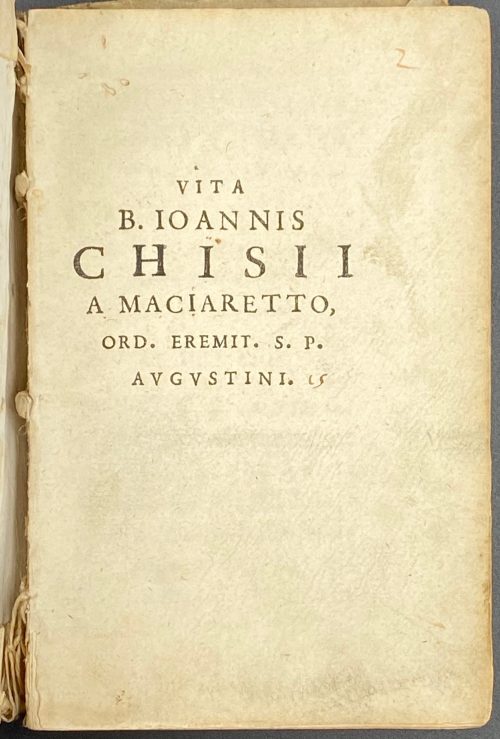 [Michael Hoyer]. Vita B. Ioannis Chisii a Maciaretto, ord. ermit. s. p. Augustini. — Antverpiæ, Apud Henricum Aertssens, Anno MDCXLI [1641]. Pagination: [2] *3+recto unpag. *4+recto unpag., [10], 5-135 [3]. Illustrations: Frontispiece missing, 4 copperplate engravings (pp. 22, 64, 90, and 120) by Pieter de Jode the Younger (1606–1674, Flemish printmaker, draughtsman, painter and art dealer) after Erasmus Quellinus the Younger (1607–1678, Flemish painter, engraver, draughtsman and tapestry designer). Size: Pott 8vo (15.5 x 10 cm), vellum binding. Expanded title: Vita Beati Ioannis Chisii, a Maciaretto, Ordinis Eremitarum Sancti Patris Augustini. [Translation: Life of Blessed Giovanni Chigi from Maciaretto, Order of Hermits of St. Augustine]. Blessed Giovanni Chigi (1300 - 1363) [1] was a lay brother of the Order of Hermits of St. Augustine. The Chigi family is a Roman princely family of Sienese extraction descended from the counts of Ardenghesca. The earliest authentic mention of them is in the 13th century, with one Alemanno, counsellor of the Republic of Siena. The Wikipedia article does not mention Giovanni Chigi, however, it states that one of the Chigi, Cardinal Fabio Chigi, was elected pope as Alexander VII at the Conclave of 1655. The book was published in 1641 with a dedication to the said Cardinal Fabio Chigi before he was elected pope. The town, Maciaretto, where Giovanni Chigi was from, is unclear because there is no such place in modern Italy, and there are two places called Macereto: (1) Macereto Alta/Basso in Perugia province and (2) Macereto in the municipality of Visso, in the province of Macerata, region Marche. I assume that our Giovanni Chigi was from the one that is closer to Siena, i.e. Macereto in Perugia province. Regarding the author. There is no author's name in the book. However, in various sources, the book is mentioned as written by Michel Hoyer, who was born in Hesdin, Flanders in 1593 and died in 1650. He pursued an ecclesiastical career and professed rhetoric at the College of Saint Pierre in Lille. He later joined the Order of Saint Augustine, in the convent of Ypres, and settled in various schools in the Netherlands. His reputation attracted many students, among them Albert Rubens (1614–1657), the eldest son of Peter Paul Rubens and Isabella Brant. Michel Hoyer wrote several books, the most known is Flammulae amoris, S.P. Augustini versibus et iconibus exornatae:
[Michael Hoyer]. Vita B. Ioannis Chisii a Maciaretto, ord. ermit. s. p. Augustini. — Antverpiæ, Apud Henricum Aertssens, Anno MDCXLI [1641]. Pagination: [2] *3+recto unpag. *4+recto unpag., [10], 5-135 [3]. Illustrations: Frontispiece missing, 4 copperplate engravings (pp. 22, 64, 90, and 120) by Pieter de Jode the Younger (1606–1674, Flemish printmaker, draughtsman, painter and art dealer) after Erasmus Quellinus the Younger (1607–1678, Flemish painter, engraver, draughtsman and tapestry designer). Size: Pott 8vo (15.5 x 10 cm), vellum binding. Expanded title: Vita Beati Ioannis Chisii, a Maciaretto, Ordinis Eremitarum Sancti Patris Augustini. [Translation: Life of Blessed Giovanni Chigi from Maciaretto, Order of Hermits of St. Augustine]. Blessed Giovanni Chigi (1300 - 1363) [1] was a lay brother of the Order of Hermits of St. Augustine. The Chigi family is a Roman princely family of Sienese extraction descended from the counts of Ardenghesca. The earliest authentic mention of them is in the 13th century, with one Alemanno, counsellor of the Republic of Siena. The Wikipedia article does not mention Giovanni Chigi, however, it states that one of the Chigi, Cardinal Fabio Chigi, was elected pope as Alexander VII at the Conclave of 1655. The book was published in 1641 with a dedication to the said Cardinal Fabio Chigi before he was elected pope. The town, Maciaretto, where Giovanni Chigi was from, is unclear because there is no such place in modern Italy, and there are two places called Macereto: (1) Macereto Alta/Basso in Perugia province and (2) Macereto in the municipality of Visso, in the province of Macerata, region Marche. I assume that our Giovanni Chigi was from the one that is closer to Siena, i.e. Macereto in Perugia province. Regarding the author. There is no author's name in the book. However, in various sources, the book is mentioned as written by Michel Hoyer, who was born in Hesdin, Flanders in 1593 and died in 1650. He pursued an ecclesiastical career and professed rhetoric at the College of Saint Pierre in Lille. He later joined the Order of Saint Augustine, in the convent of Ypres, and settled in various schools in the Netherlands. His reputation attracted many students, among them Albert Rubens (1614–1657), the eldest son of Peter Paul Rubens and Isabella Brant. Michel Hoyer wrote several books, the most known is Flammulae amoris, S.P. Augustini versibus et iconibus exornatae: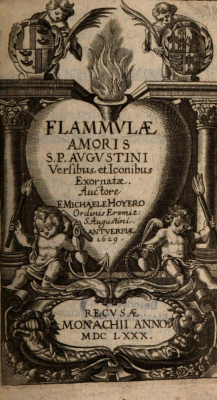 Surprisingly, there is only limited information about Michel Hoyer in Spanish Wikipedia; other language versions of his biography do not exist. Another author mentioned in the book is some anonymous Augustinian from Cologne.
Regarding the illustrations. In our copy, the frontispiece is missing. It was probably ripped off by some unscrupulous seller of antique prints.
The image on the missing frontispiece is this:
Surprisingly, there is only limited information about Michel Hoyer in Spanish Wikipedia; other language versions of his biography do not exist. Another author mentioned in the book is some anonymous Augustinian from Cologne.
Regarding the illustrations. In our copy, the frontispiece is missing. It was probably ripped off by some unscrupulous seller of antique prints.
The image on the missing frontispiece is this:
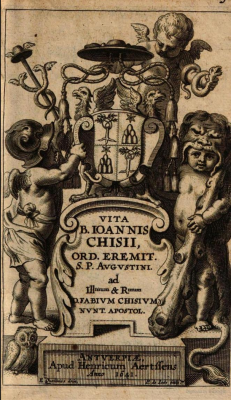 The names of the artists engraved in the bottom of the stone: E. Quellinus, delin. to the left and P. de Jode, fecit. to the right. We can infer that the other illustrations in that book are produced by the same duo. The image represents three cherubs: one with Athena's serpent in his left hand and a cardinal's hat in his right hand; another in Athen's helmet on his head and her owl beside his feet, with the staff of Mercurius (serpent-twined staff adorned with a winged hat) in his left hand, and the House of Chigi - Della Rovere coat of arms in his right hand; the third cherub depicted with the Hercules attributes - lion pelt and a club.
Regarding the publisher. Henricum Aertssens or Hendrik Aertssen, 1586-1658. Besides the other books, he published PIA DESIDERIA by Herman Hugo in 1636 [1621 french edition by Jean Cnobbartin in Antwerp in his collection LIB-1657.2018]. According to Nina Lamal [2], nothing is known about career of this publisher, besides what's said in Adresboek van zeventiende-eeuwse drukkers, uitgevers en boekverkopers in Vlaanderen / Directory of seventeenth-century Printers, Publishers and Booksellers in Flanders / Vlieger-De Wilde, Koen De (editor). The list of his publications can be seen here.
Other artists who turned to the figure of Blessed Giovanni Chigi were Abraham van Diepenbeeck (painter) and Conrad Lauwers (engraver). The print is in Rijksmuseum, in Amsterdam.
The names of the artists engraved in the bottom of the stone: E. Quellinus, delin. to the left and P. de Jode, fecit. to the right. We can infer that the other illustrations in that book are produced by the same duo. The image represents three cherubs: one with Athena's serpent in his left hand and a cardinal's hat in his right hand; another in Athen's helmet on his head and her owl beside his feet, with the staff of Mercurius (serpent-twined staff adorned with a winged hat) in his left hand, and the House of Chigi - Della Rovere coat of arms in his right hand; the third cherub depicted with the Hercules attributes - lion pelt and a club.
Regarding the publisher. Henricum Aertssens or Hendrik Aertssen, 1586-1658. Besides the other books, he published PIA DESIDERIA by Herman Hugo in 1636 [1621 french edition by Jean Cnobbartin in Antwerp in his collection LIB-1657.2018]. According to Nina Lamal [2], nothing is known about career of this publisher, besides what's said in Adresboek van zeventiende-eeuwse drukkers, uitgevers en boekverkopers in Vlaanderen / Directory of seventeenth-century Printers, Publishers and Booksellers in Flanders / Vlieger-De Wilde, Koen De (editor). The list of his publications can be seen here.
Other artists who turned to the figure of Blessed Giovanni Chigi were Abraham van Diepenbeeck (painter) and Conrad Lauwers (engraver). The print is in Rijksmuseum, in Amsterdam.
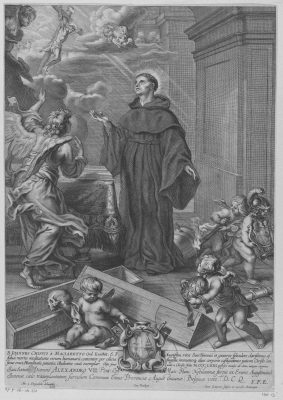 Here we see a more complex composition but with a clear reference to the work of Quellinus and de Jode: The cherub in Athena's helmet takes away the old coat of arms of the Chigi, and the other cherub points out to the new one, with papal symbols of St. Peter's keys, another cherub carries the papal tiara. Rijksmuseum dates the image as 1642 - 1685; most probably it is ca. 1655, when Fabio Chigi became Pope Alexander VII, and propaganda was focused on promoting his outstanding ancestor Giovanni, who died 300 years before. Giovanni Chigi is depicted here resurrected, accompanied by the archangel, and receiving the blessing from Jesus on the cross.
1 - Michael J. Walsh. A New Dictionary of Saints: East and West, p. 308.
2 - Nina Lamal. Publishing military books in the Low Countries and in Italy in the early seventeenth century in 'Specialist Markets in the Early Modern Book World', ed. Richard Kirwan, Sophia Mullins, Leiden: Koninklijke Brill, 2015, pp. 232-233.
Here we see a more complex composition but with a clear reference to the work of Quellinus and de Jode: The cherub in Athena's helmet takes away the old coat of arms of the Chigi, and the other cherub points out to the new one, with papal symbols of St. Peter's keys, another cherub carries the papal tiara. Rijksmuseum dates the image as 1642 - 1685; most probably it is ca. 1655, when Fabio Chigi became Pope Alexander VII, and propaganda was focused on promoting his outstanding ancestor Giovanni, who died 300 years before. Giovanni Chigi is depicted here resurrected, accompanied by the archangel, and receiving the blessing from Jesus on the cross.
1 - Michael J. Walsh. A New Dictionary of Saints: East and West, p. 308.
2 - Nina Lamal. Publishing military books in the Low Countries and in Italy in the early seventeenth century in 'Specialist Markets in the Early Modern Book World', ed. Richard Kirwan, Sophia Mullins, Leiden: Koninklijke Brill, 2015, pp. 232-233.
-
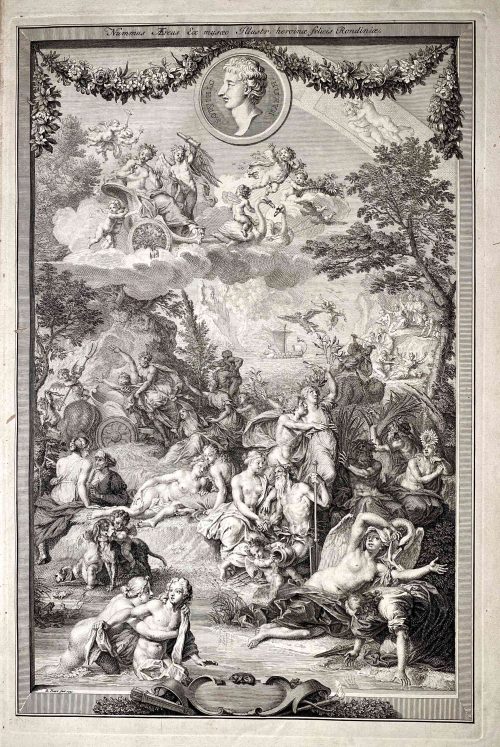 Vol. 1 title: OVID'S | METAMORPHOSES | IN LATIN AND ENGLISH, | TRANSLATED BY | THE MOST EMINENT HANDS. | With HISTORICAL EXPLICATIONS | Of the FABLES, | WRITTEN IN FRENCH BY | The ABBOT BANIER, | MEMBER OF THE ACADEMY OF INSCRIPTIONS | AND BELLES LETTRES. | TRANSLATED INTO ENGLISH. | Adorned with Sculptures, by B. Picart, and other able Masters. | VOLUME THE FIRST. | [Device] | AMSTERDAM, | Printed for the WETSTEINS and SMITH. | MD CC XXII || — Pagination: [26 – Half-title, frontis., t.p., dedic., The Bookseller's Preface To This Edition, Mr. Banier's Preface To The French Translation, Contents], [1] 2-247 – Text of books 1-7, with illus., [1 blank]. Vol. 2 half-title: OVID'S | METAMORPHOSES | IN LATIN AND ENGLISH | TWO VOLUMES || — Pagination: [2 – half-title / blank], 249-524 – Text of books 8-15, with illus., incl. 3 leaves of pl., [4 – Index]. Three leaves between pages 264 and 271 are included in the pagination as pp. [265-70] but do not carry page-numbers or letterpress text. They each carry two prints on their rectos and are blank on the verso. Vol. II without the engraved title page. The names of the translators are given in the list of Contents as Dryden, Addison, Eusden, Arthur Mainwaring, Croxall, Tate, Stonestreet, Vernon, Gay, Pope, Stephen Harvey, Congreve, Ozel, Temple Stanyan, , Catcot, Rowe, Samuel Garth, Welsted. The frontispiece is signed as made by B. Picart. The six plates on pages [265, 267, 269] are all signed as painted by C. Le Brun and engraved by Iakob Folkema. Of the 124 illustrations, most are unsigned by a draughtsman, but some are signed as designed by G. Maas, one as designed by Jul. Romain, two as designed by G. Maas and drawn by J. de Wit, one as drawn by 'HA', one as painted by C. le Brun, one as made by B. Picart, one as designed by P. Testa and drawn by B. Picart, one as designed by S. Le Clerc, one as designed by B. Picart. Many are signed by their engravers - Philip à Gunst (one as directed by B. Picart and engraved by Phil. à Gunst), J. Vandelaar (or I. Wandelaar), Martin Bouche, Jan Schenck, 'MB', Petr. Paul. Bouche, Iakob Folkema, W. Jongman, Fred. Bouttats. The title-page vignette of Volume I is signed as drawn by B. v. Overbeke and engraved by F. Mulder. Many tailpieces are signed 'VLS'. The book is dedicated by the publishers, R. and J. Wetstein and W. Smith, to the Countess of Pembroke. [Description is cited from the Royal Academy of Arts] Physical description: Two large 4to volumes, first title page printed in red and black, added engraved title in the first volume; half-title in the second volume; illustrated throughout with copperplate engravings in text; text printed in parallel columns in Latin and English; three leaves extraneous to collation each with two engravings in the second volume; bookplate pasted to the front endpaper in each volume: Ex Libris Theodore C. Tebbetts (Theodore Charles Tebbetts, American, 1871 – 1920) designed after Francis Carruthers Gould (British, 1844 – 1925); pages 517-520 of the second volume torn with loss of bottom blank corners and a word or two; original full leather, spines tooled elaborately in gilt; some boards detached, endcaps and corners rather worn, contents bright and fresh. Size: Large 4to; 47.5 x 31 cm.
Vol. 1 title: OVID'S | METAMORPHOSES | IN LATIN AND ENGLISH, | TRANSLATED BY | THE MOST EMINENT HANDS. | With HISTORICAL EXPLICATIONS | Of the FABLES, | WRITTEN IN FRENCH BY | The ABBOT BANIER, | MEMBER OF THE ACADEMY OF INSCRIPTIONS | AND BELLES LETTRES. | TRANSLATED INTO ENGLISH. | Adorned with Sculptures, by B. Picart, and other able Masters. | VOLUME THE FIRST. | [Device] | AMSTERDAM, | Printed for the WETSTEINS and SMITH. | MD CC XXII || — Pagination: [26 – Half-title, frontis., t.p., dedic., The Bookseller's Preface To This Edition, Mr. Banier's Preface To The French Translation, Contents], [1] 2-247 – Text of books 1-7, with illus., [1 blank]. Vol. 2 half-title: OVID'S | METAMORPHOSES | IN LATIN AND ENGLISH | TWO VOLUMES || — Pagination: [2 – half-title / blank], 249-524 – Text of books 8-15, with illus., incl. 3 leaves of pl., [4 – Index]. Three leaves between pages 264 and 271 are included in the pagination as pp. [265-70] but do not carry page-numbers or letterpress text. They each carry two prints on their rectos and are blank on the verso. Vol. II without the engraved title page. The names of the translators are given in the list of Contents as Dryden, Addison, Eusden, Arthur Mainwaring, Croxall, Tate, Stonestreet, Vernon, Gay, Pope, Stephen Harvey, Congreve, Ozel, Temple Stanyan, , Catcot, Rowe, Samuel Garth, Welsted. The frontispiece is signed as made by B. Picart. The six plates on pages [265, 267, 269] are all signed as painted by C. Le Brun and engraved by Iakob Folkema. Of the 124 illustrations, most are unsigned by a draughtsman, but some are signed as designed by G. Maas, one as designed by Jul. Romain, two as designed by G. Maas and drawn by J. de Wit, one as drawn by 'HA', one as painted by C. le Brun, one as made by B. Picart, one as designed by P. Testa and drawn by B. Picart, one as designed by S. Le Clerc, one as designed by B. Picart. Many are signed by their engravers - Philip à Gunst (one as directed by B. Picart and engraved by Phil. à Gunst), J. Vandelaar (or I. Wandelaar), Martin Bouche, Jan Schenck, 'MB', Petr. Paul. Bouche, Iakob Folkema, W. Jongman, Fred. Bouttats. The title-page vignette of Volume I is signed as drawn by B. v. Overbeke and engraved by F. Mulder. Many tailpieces are signed 'VLS'. The book is dedicated by the publishers, R. and J. Wetstein and W. Smith, to the Countess of Pembroke. [Description is cited from the Royal Academy of Arts] Physical description: Two large 4to volumes, first title page printed in red and black, added engraved title in the first volume; half-title in the second volume; illustrated throughout with copperplate engravings in text; text printed in parallel columns in Latin and English; three leaves extraneous to collation each with two engravings in the second volume; bookplate pasted to the front endpaper in each volume: Ex Libris Theodore C. Tebbetts (Theodore Charles Tebbetts, American, 1871 – 1920) designed after Francis Carruthers Gould (British, 1844 – 1925); pages 517-520 of the second volume torn with loss of bottom blank corners and a word or two; original full leather, spines tooled elaborately in gilt; some boards detached, endcaps and corners rather worn, contents bright and fresh. Size: Large 4to; 47.5 x 31 cm. -
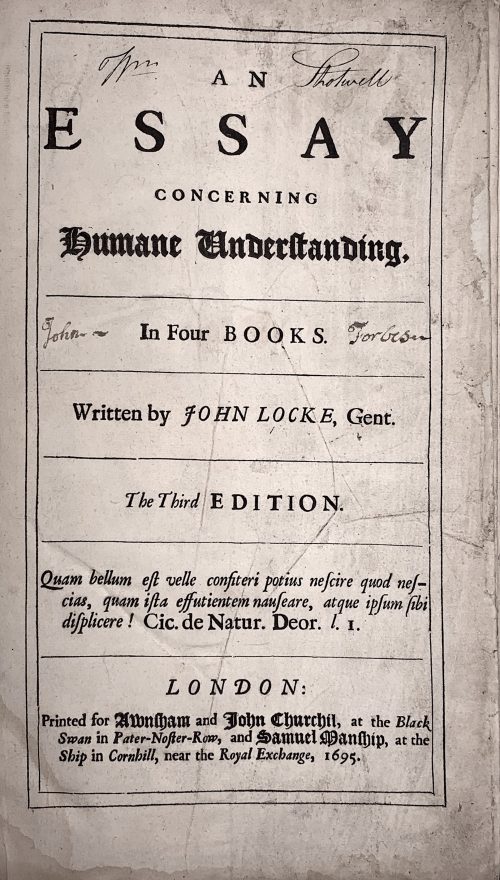 Title: AN | ESSAY | CONCERNING | HUMANE UNDERSTANDING, |—| In Four BOOKS. |—| Written by JOHN LOCKE, Gent. |—| The Third EDITION. |—| Quam bellum est velle confiteri potius nescire quod nes- | cias, quam ista effutientem nauseare, atque ipsum sibi | displicere! Cic. De Natur. Deor. l. I. |—| LONDON: | Printed for Awnsham and John Churchil, at the Black | Swan in Pater-Noster-Row, and Samuel Manship, at the | Ship in Cornhill, near the Royal Exchange, 1695. Collation: [π2]-b6, a-c4, B-Z4 Aa-Zz4 Aaa-Fff4 Ggg-Iii2 Pagination: [40] 1-407 [13]. Catalogue raisoné: The works of John Locke; a comprehensive bibliography from the seventeenth century to the present. Compiled by John C. Attig. Series: Bibliographies and Indexes in Philosophy, Number 1. Greenwood Press, Westport, CT & London, England, 1985. p. 42, №230 provides for pagination [40] 407, [13]p. Page by page reprint of 1694 edition. Regarding the epigraph on t.p.: The correct citation from , De Natura Deorum: "Quam bellum erat, Vellei, confiteri potius nescire, quod nescires, quam ista effutientem nauseare atque ipsum sibi displicere." [How delightful it would be, Velleius, if when you did not know a thing you would admit your ignorance, instead of uttering this drivel, which must make even your own gorge rise with disgust!] This life-time edition was presented as a gift to Dr Elisha Atkins (1949 – 2019), professor at Yale University School of Medicine, on July 1st, 1967, by his students, namely Carolyn Wells [Bush] (1923 – 2013), John Mooney (now a psychiatrist in Boston), and Charles Dinarello. Size: 32 x 23 cm Binding: Fill modern morocco, panelled and ruled gilt, raised bands, gilt in compartments, red label with gilt lettering; in a slipcase.
Title: AN | ESSAY | CONCERNING | HUMANE UNDERSTANDING, |—| In Four BOOKS. |—| Written by JOHN LOCKE, Gent. |—| The Third EDITION. |—| Quam bellum est velle confiteri potius nescire quod nes- | cias, quam ista effutientem nauseare, atque ipsum sibi | displicere! Cic. De Natur. Deor. l. I. |—| LONDON: | Printed for Awnsham and John Churchil, at the Black | Swan in Pater-Noster-Row, and Samuel Manship, at the | Ship in Cornhill, near the Royal Exchange, 1695. Collation: [π2]-b6, a-c4, B-Z4 Aa-Zz4 Aaa-Fff4 Ggg-Iii2 Pagination: [40] 1-407 [13]. Catalogue raisoné: The works of John Locke; a comprehensive bibliography from the seventeenth century to the present. Compiled by John C. Attig. Series: Bibliographies and Indexes in Philosophy, Number 1. Greenwood Press, Westport, CT & London, England, 1985. p. 42, №230 provides for pagination [40] 407, [13]p. Page by page reprint of 1694 edition. Regarding the epigraph on t.p.: The correct citation from , De Natura Deorum: "Quam bellum erat, Vellei, confiteri potius nescire, quod nescires, quam ista effutientem nauseare atque ipsum sibi displicere." [How delightful it would be, Velleius, if when you did not know a thing you would admit your ignorance, instead of uttering this drivel, which must make even your own gorge rise with disgust!] This life-time edition was presented as a gift to Dr Elisha Atkins (1949 – 2019), professor at Yale University School of Medicine, on July 1st, 1967, by his students, namely Carolyn Wells [Bush] (1923 – 2013), John Mooney (now a psychiatrist in Boston), and Charles Dinarello. Size: 32 x 23 cm Binding: Fill modern morocco, panelled and ruled gilt, raised bands, gilt in compartments, red label with gilt lettering; in a slipcase. -
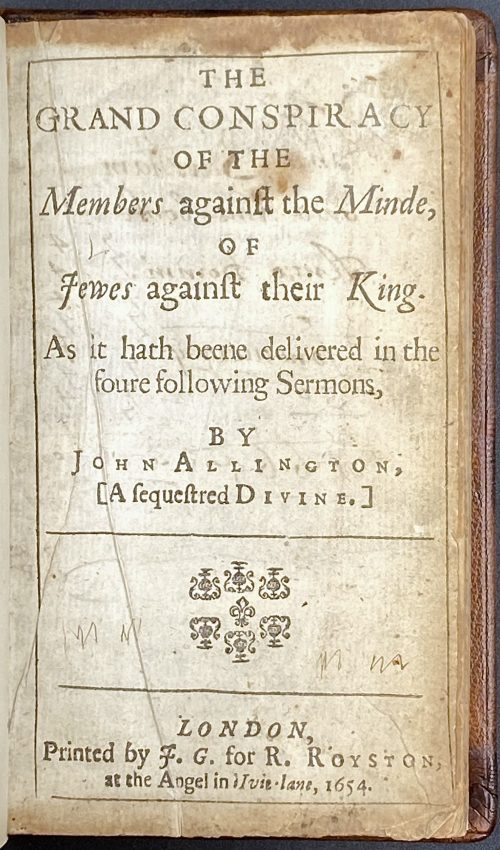 Title: THE | GRAND CONSPIRACY | OF THE | Members again∫t the Minde, | OF | Jewes again∫t their King. | As it hath beene delivered in the | foure following Sermons, | BY | John Allington, [A ∫eque∫tered Divine.] | — | {ornament} | — | LONDON, | Printed by J.G. for R. Royston, | at the Angel in Ivie-lane, 1654.|| Contents: Grand conspiracy of Jewes against their King. A sermon preached in August 1647; Grand conspiracy of Jewes against their King. A sermon preached in January 1649; Grand conspiracy of Jewes against their King. A demonstration of the highest insolencies proceed from men of the lowest and most base extractions Pagination: [2] – t.p. / blank; 1-214. Collation: 12mo; A-I12. Binding: Hardcover; 15 x 9.5 cm, later blind-stamped morocco, raised bands, gilt lettering in compartments. Inscription: Ink by hand by John Bartham, January 30, 1665, to t.p. verso; Pencil by hand to front pastedown: Wing A 1209A.
Title: THE | GRAND CONSPIRACY | OF THE | Members again∫t the Minde, | OF | Jewes again∫t their King. | As it hath beene delivered in the | foure following Sermons, | BY | John Allington, [A ∫eque∫tered Divine.] | — | {ornament} | — | LONDON, | Printed by J.G. for R. Royston, | at the Angel in Ivie-lane, 1654.|| Contents: Grand conspiracy of Jewes against their King. A sermon preached in August 1647; Grand conspiracy of Jewes against their King. A sermon preached in January 1649; Grand conspiracy of Jewes against their King. A demonstration of the highest insolencies proceed from men of the lowest and most base extractions Pagination: [2] – t.p. / blank; 1-214. Collation: 12mo; A-I12. Binding: Hardcover; 15 x 9.5 cm, later blind-stamped morocco, raised bands, gilt lettering in compartments. Inscription: Ink by hand by John Bartham, January 30, 1665, to t.p. verso; Pencil by hand to front pastedown: Wing A 1209A. -
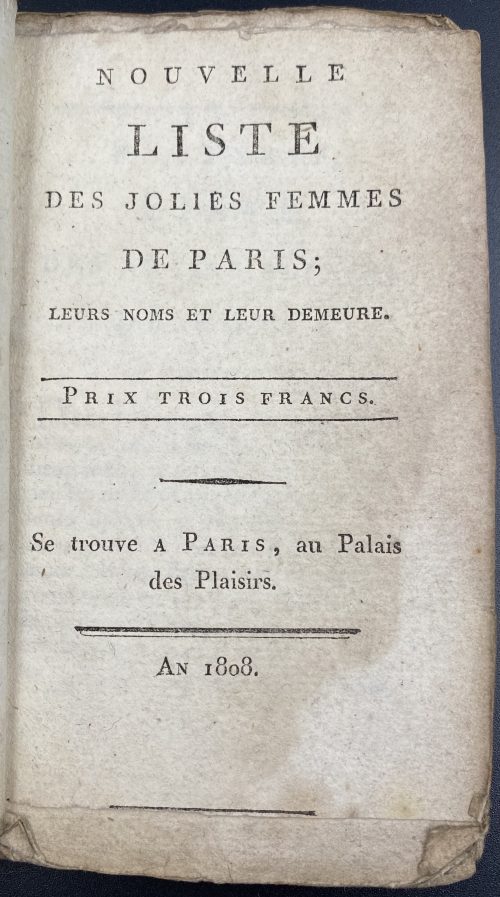 Title: NOUVELLE | LISTE | DES JOLIES FEMMES | DE PARIS ; | LEURS NOMS ET LEUR DEMEURE. | PRIX TROIS FRANCS. | Se trouve A Paris , au Palais des plaisirs. | — | An 1808. || Pagination : [1-6] 7-70 [2 blank] Collation : 9vo, [A]9 B-D9. Binding: Original blue wrappers, 15 x 9 cm. Ref: OCLC finds only one copy, at the British Library. The BnF has a work of the same title, with the same pagination, dated 1803. The stated publisher seems to be fictitious. Quaritch description: 12mo, pp. 70; a little dusty, a few spots and marks; a very good uncut copy in original blue/grey wrappers; somewhat worn and stained. Very rare guide to Parisian prostitutes providing an extraordinary snapshot of the state of prostitution in the city during the First French Empire. The anonymous compiler begins with a brief history of prostitution in the capital, and its regulation, under Charlemagne and Louis VIII, describes a brothel established by Joanna I of Naples at Avignon and discusses Pierre-Jean Grosley’s estimate of the number of prostitutes in London. He then provides his liste, divided into categories including ‘houses of the first order’, ‘bawdy houses’, ‘actresses’, ‘washerwomen’, and ‘procuresses’, giving the name of each prostitute, an indication of their age, and their physical attributes, character, and particular talents. Rosanne, for example, chez Madame l’Évêque at the Palais du Tribunat, offers ‘unspeakably voluptuous pleasures to the nether regions’; Honorine prefers women; Scholastique likes wine with her lovemaking; Nanette has a penchant for soldiers; Genevieve favours the priapic; Dorsay enjoys S&M, and Madame Laperriere promises rejuvenation to the elderly. One Ducroisy is poetically described as possessing ‘a tuft as black as a crow above two alabaster columns’, while Félicité has skin ‘soft and white, sprinkled with golden freckles, like gold in Maraschino liqueur’. The author hopes that his listed will bring business to the ladies and pleasure to their clients, beseeching both to look after their health so that his guide might ‘serve Love, not Asclepius’.
Title: NOUVELLE | LISTE | DES JOLIES FEMMES | DE PARIS ; | LEURS NOMS ET LEUR DEMEURE. | PRIX TROIS FRANCS. | Se trouve A Paris , au Palais des plaisirs. | — | An 1808. || Pagination : [1-6] 7-70 [2 blank] Collation : 9vo, [A]9 B-D9. Binding: Original blue wrappers, 15 x 9 cm. Ref: OCLC finds only one copy, at the British Library. The BnF has a work of the same title, with the same pagination, dated 1803. The stated publisher seems to be fictitious. Quaritch description: 12mo, pp. 70; a little dusty, a few spots and marks; a very good uncut copy in original blue/grey wrappers; somewhat worn and stained. Very rare guide to Parisian prostitutes providing an extraordinary snapshot of the state of prostitution in the city during the First French Empire. The anonymous compiler begins with a brief history of prostitution in the capital, and its regulation, under Charlemagne and Louis VIII, describes a brothel established by Joanna I of Naples at Avignon and discusses Pierre-Jean Grosley’s estimate of the number of prostitutes in London. He then provides his liste, divided into categories including ‘houses of the first order’, ‘bawdy houses’, ‘actresses’, ‘washerwomen’, and ‘procuresses’, giving the name of each prostitute, an indication of their age, and their physical attributes, character, and particular talents. Rosanne, for example, chez Madame l’Évêque at the Palais du Tribunat, offers ‘unspeakably voluptuous pleasures to the nether regions’; Honorine prefers women; Scholastique likes wine with her lovemaking; Nanette has a penchant for soldiers; Genevieve favours the priapic; Dorsay enjoys S&M, and Madame Laperriere promises rejuvenation to the elderly. One Ducroisy is poetically described as possessing ‘a tuft as black as a crow above two alabaster columns’, while Félicité has skin ‘soft and white, sprinkled with golden freckles, like gold in Maraschino liqueur’. The author hopes that his listed will bring business to the ladies and pleasure to their clients, beseeching both to look after their health so that his guide might ‘serve Love, not Asclepius’. -
![Maurice Joly. Les affamés. Études de mœurs contemporaines. — Paris, E. Dentu, 1876. — pp.: [1 half-title, verso colophone] [1 title, verso blank] [i] ii-xvi, 1-340.](https://varshavskycollection.com/wp-content/uploads/2021/02/LIB-1038.2016-a-500x772.jpeg) Title page: MAURICE JOLY | LES | AFFAMÉS | ÉTUDES | DE MŒURS CONTEMPORAINES |{publisher’s device «ED»}| PARIS | E. DENTU, LIBRAIRE-ÉDITEUR | PALAIS-ROYAL, 15-17-19, GALERIE D’ORLÉANS | 1876 | Tous droits réservés.|| Pagination: short ffl, [2] h.t. / colophon [2] t.p. / blank] [i] ii-xvi, 1-340. Collation: 12mo ; π10 1-1812 198. Binding: 19 x 12 cm; softcover; original wrappers with lettering to front and spine in black and red in a frame, untrimmed lateral edge.
Title page: MAURICE JOLY | LES | AFFAMÉS | ÉTUDES | DE MŒURS CONTEMPORAINES |{publisher’s device «ED»}| PARIS | E. DENTU, LIBRAIRE-ÉDITEUR | PALAIS-ROYAL, 15-17-19, GALERIE D’ORLÉANS | 1876 | Tous droits réservés.|| Pagination: short ffl, [2] h.t. / colophon [2] t.p. / blank] [i] ii-xvi, 1-340. Collation: 12mo ; π10 1-1812 198. Binding: 19 x 12 cm; softcover; original wrappers with lettering to front and spine in black and red in a frame, untrimmed lateral edge. -
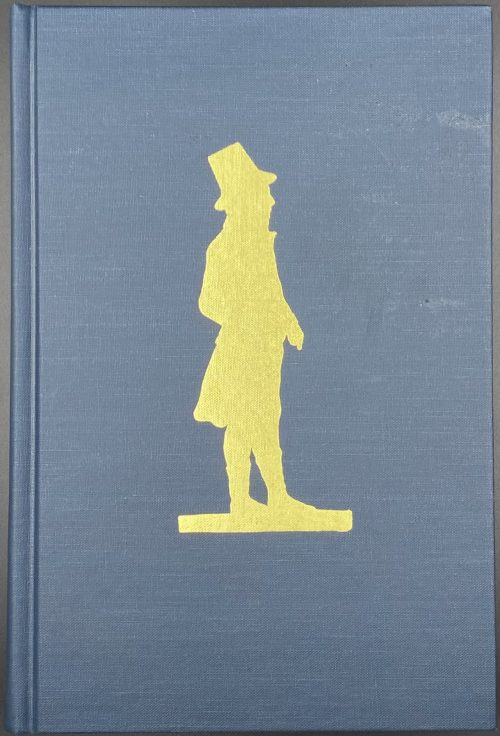 Title: THOMAS FROGNALL DIBDIN | 1776-1847 | A Bibliography | By John Windle and Karma Pippin | Oak Knoll Press | New Castle Delaware | 1999 || Pagination: [2 blanks] [i, ii] – standing silhouette / frontis. with buste portrait 1821 (misspelled "Didbin"), [iii, iv] – t.p. / colophon, [v, vi] – dedication / blank, [vii, viii] – contents / blank, [ix, x] – illustr. / portrait 1816, [xi] xii-xxiii [xxiv] [1] 2-284 [2]. Binding: 23.5 x 16 cm, hardcover, publisher’s blue cloth gilt-stamped with a standing silhouette of T. F. Dibdin to cover, gilt lettering to spine.
Title: THOMAS FROGNALL DIBDIN | 1776-1847 | A Bibliography | By John Windle and Karma Pippin | Oak Knoll Press | New Castle Delaware | 1999 || Pagination: [2 blanks] [i, ii] – standing silhouette / frontis. with buste portrait 1821 (misspelled "Didbin"), [iii, iv] – t.p. / colophon, [v, vi] – dedication / blank, [vii, viii] – contents / blank, [ix, x] – illustr. / portrait 1816, [xi] xii-xxiii [xxiv] [1] 2-284 [2]. Binding: 23.5 x 16 cm, hardcover, publisher’s blue cloth gilt-stamped with a standing silhouette of T. F. Dibdin to cover, gilt lettering to spine. -
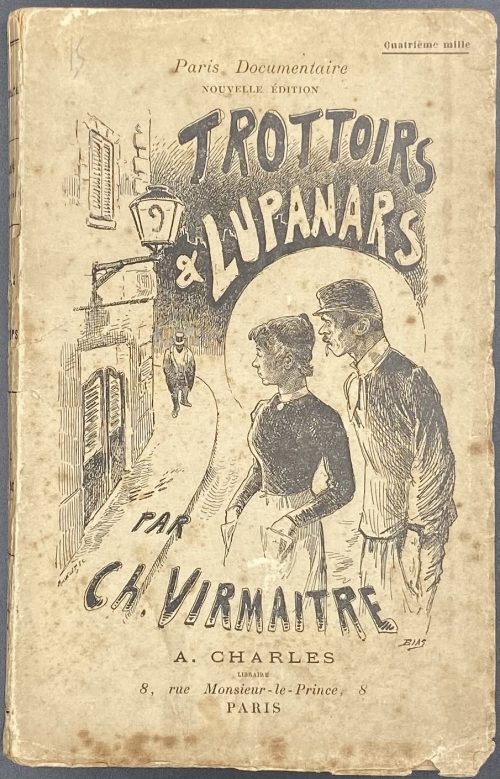 Front wrapper: Quatrième mille | Paris Documentaire | NOUVELLE ÉDITION | TROTTOIRS | ET | LUPANARS | PAR | Ch. VIRMAITRE | A. CHARLES | LIBRAIRE | 8, Rue Monsieur-le-Prince, 8 | PARIS || Title page: Ch. VIRMAITRE | PARIS DOCUMENTAIRE | (Mœurs) | TROTTOIRS | ET | LUPANARS | {fleuron} | A. CHARLES | LIBRAIRE | 8, Rue Monsieur-le-Prince, 8 | PARIS | 1897 || Collation: 18mo; Front pictorial wrapper, 2 ffls, π4, 118, 318, 518, 718, 918, 1118, 1318, 1514, back pictorial wrapper (portrait) Pagination: [1-7] 8-282 [6]. Binding: Publisher’s pictorial wrappers, lettering to spine. Charles Virmaître (French, 1835 – 1903).
Front wrapper: Quatrième mille | Paris Documentaire | NOUVELLE ÉDITION | TROTTOIRS | ET | LUPANARS | PAR | Ch. VIRMAITRE | A. CHARLES | LIBRAIRE | 8, Rue Monsieur-le-Prince, 8 | PARIS || Title page: Ch. VIRMAITRE | PARIS DOCUMENTAIRE | (Mœurs) | TROTTOIRS | ET | LUPANARS | {fleuron} | A. CHARLES | LIBRAIRE | 8, Rue Monsieur-le-Prince, 8 | PARIS | 1897 || Collation: 18mo; Front pictorial wrapper, 2 ffls, π4, 118, 318, 518, 718, 918, 1118, 1318, 1514, back pictorial wrapper (portrait) Pagination: [1-7] 8-282 [6]. Binding: Publisher’s pictorial wrappers, lettering to spine. Charles Virmaître (French, 1835 – 1903). -
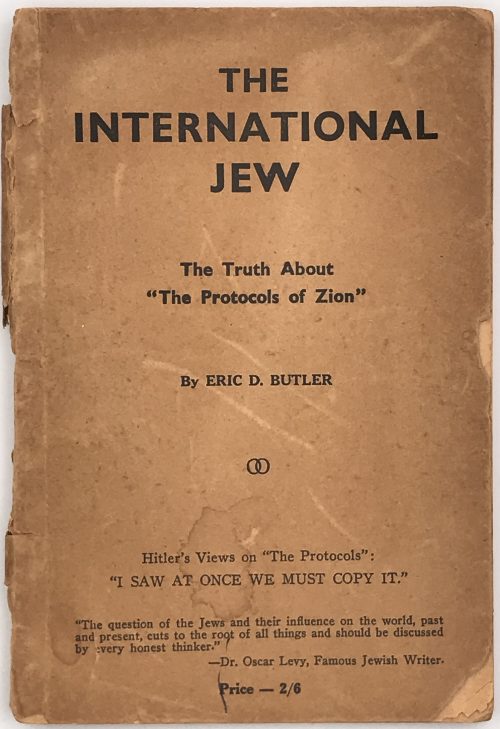 Front wrapper and t.p.: THE | INTERNATIONAL | JEW | The Truth About | "The Protocols of Zion" | By ERIC D. BUTLER | ∞ | Hitler’s Views on “The Protocols”: | “I SAW AT ONCE WE MUST COPY IT.” | “The question of the Jews and their influence on the world, past and present, cuts to the root of all things and should be discussed by every honest thinker” | — Dr. Oscar Levy, Famous Jewish Writer. | Price — 2/6 || (T.p.: same with the full stop (.) after 2/6. Stamp to t.p.: Women’s Voice | 537 SO. DEARBORN ST. | ROOM 800 | CHICAGO 5. ILL. || [2] 3-167 [168]. Binding: Lettered publisher’s wrappers, 18 x 12 cm. Butler, Eric Dudley (Australian, 1916 – 2006) Osborne, Robert Martin (British-Australian, 1862 – 1931) — Australian printer and publisher. Levy, Oscar (German-Jewish, 1867 – 1946) Hitler, Adolf (German, 1889 – 1945)
Front wrapper and t.p.: THE | INTERNATIONAL | JEW | The Truth About | "The Protocols of Zion" | By ERIC D. BUTLER | ∞ | Hitler’s Views on “The Protocols”: | “I SAW AT ONCE WE MUST COPY IT.” | “The question of the Jews and their influence on the world, past and present, cuts to the root of all things and should be discussed by every honest thinker” | — Dr. Oscar Levy, Famous Jewish Writer. | Price — 2/6 || (T.p.: same with the full stop (.) after 2/6. Stamp to t.p.: Women’s Voice | 537 SO. DEARBORN ST. | ROOM 800 | CHICAGO 5. ILL. || [2] 3-167 [168]. Binding: Lettered publisher’s wrappers, 18 x 12 cm. Butler, Eric Dudley (Australian, 1916 – 2006) Osborne, Robert Martin (British-Australian, 1862 – 1931) — Australian printer and publisher. Levy, Oscar (German-Jewish, 1867 – 1946) Hitler, Adolf (German, 1889 – 1945) -
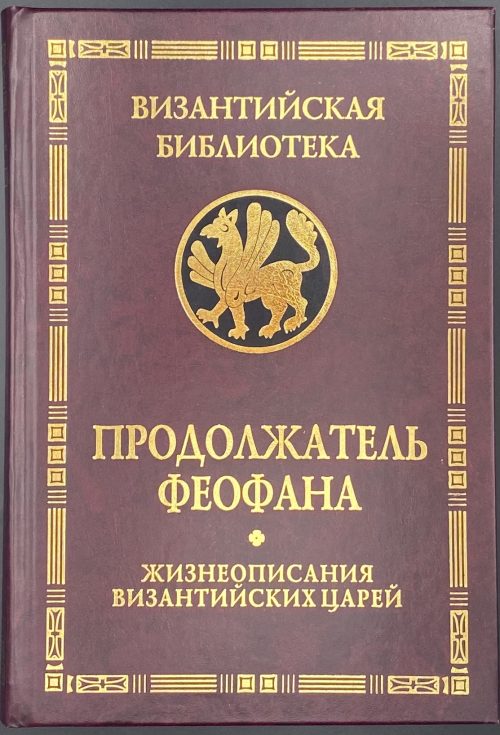 Title: ПРОДОЛЖАТЕЛЬ ФЕОФАНА | ЖИЗНЕОПИСАНИЯ | ВИЗАНТИЙСКИХ ЦАРЕЙ | Издание второе, исправленное и дополненное | Санкт-Петербург | АЛЕТЕЙЯ | 2009 || Pagination: [108] 9-398 [2]. Binding: 21.5 x 15 cm; hardcover, crimson buckram, gilt lettering in the border, gilt serial device on black, pictorial endpapers. Print run: 1,000 copies. ISBN: 978-5-91419-146-4. Theophanes Continuatus [Продолжатель Феофана; συνεχισταί Θεοφάνους] (Byzantine, 9th century). Любарский, Яков Николаевич (Russian, 1929 – 2003).
Title: ПРОДОЛЖАТЕЛЬ ФЕОФАНА | ЖИЗНЕОПИСАНИЯ | ВИЗАНТИЙСКИХ ЦАРЕЙ | Издание второе, исправленное и дополненное | Санкт-Петербург | АЛЕТЕЙЯ | 2009 || Pagination: [108] 9-398 [2]. Binding: 21.5 x 15 cm; hardcover, crimson buckram, gilt lettering in the border, gilt serial device on black, pictorial endpapers. Print run: 1,000 copies. ISBN: 978-5-91419-146-4. Theophanes Continuatus [Продолжатель Феофана; συνεχισταί Θεοφάνους] (Byzantine, 9th century). Любарский, Яков Николаевич (Russian, 1929 – 2003). -
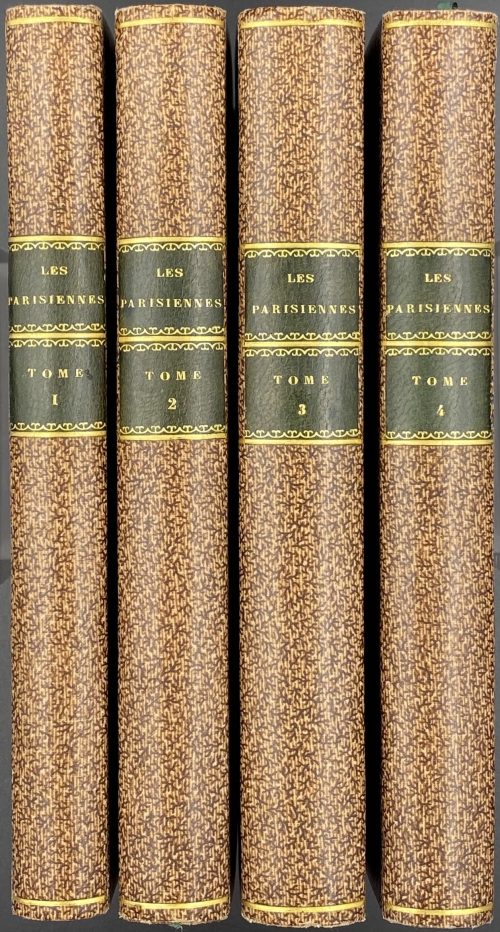 Four-volume edition with 6+4+5+5 = 20 plates. Vol. 1 : Title page, in double-border, within rules; accents as per original, with tall «s»: Les | Parisiennes, | ou | XL caractères generaux | Pris dans les Mœurs actuelles, | Propres à servir à l'instruction | des personnes-du-sexe : | Tirés des memoires du nouveau Lycée-des-mœurs. | I Volume : Les jeunes-filles, | & les filles-à-marier. | A Neufchâtel , | Et se trouve à Paris. | Chéz Guillot, libraire de Monsieur, rue | S.-Jacques, vis-à-vis celle des Mathurins. | 1787. Pagination : [1-5] 6-300, plus 6 etched/engraved plates w/guard tissue after Louis Binet (French, 1744 – about 1800). Collation: 12mo; A14 B-M12 N4; first 6 leaves in gatherings B to M signed, with exceptions: A1,2 unsigned, A3-8 signed, A9-14, D5, N3,4 unsigned. Vol. 2: Title page: Text above the first rule similar; below: II Volume : Les N.lles–mariées : | Les Mariées depuis 3 ans. | A Neufchâtel , | Et se trouve à Paris. | 1787. Pagination : [1-3] 4-388, plus 4 plates. Collation: 12mo; A8 B-Q12 R6; A1,5-8, R4-6 unsigned. Vol. 3: Title page: Text above the first rule similar; below: III Volume : Les epouses | à imiter : à— suir | A Neufchâtel , | Et se trouve à Paris. | 1787. Pagination: [1-3] 4-392, plus 5 plates. Collation: 12mo, A4 B-R12; A1,3,4, G4, N4,6, O5 unsigned. Vol 4: Title page: Text above the first rule similar; below: IV Volume : Les J.nes-Mères, | &—de grands-enfans. | A Neufchâtel , | Et se trouve à Paris. | 1787. Pagination: [1-3] 4-380 [4], plus 5 plates. Collation: A-Q12; A1 unsigned. Binding: later (c. 1875 – 1885) uniform binding of all four volumes in motley 'percaline anglaise' (buckram) with black gilt-lettered labels to spine, marbled endpapers; printed on laid paper; armorial bookplate of Masséna engraved by Stern to front pastedown. Provenance: Library of Masséna; Victor Masséna, duc de Rivoli, prince d'Essling (French, 1836 – 1910) [photo]. Catalogue Raisonné: P.-L. Jacob, 1875: № XXXII, pp. 247-250. P. L. Jacob. Bibliographie et iconographie de tous les ouvrages de Restif de la Bretonne. — Paris: A. Fontaine, 1875. [LIB-2634.2021]. Contributors: Nicolas Edmé Restif de la Bretonne (French, 1734 – 1806) – text. Louis Binet (French, 1744 – c. 1800) – illustrations. Sources: MFA: ACCESSION NUMBER 37.1667a-b lacking one plate in vol. 4. Collation: 12mo, 4 vols. in 2; [v. 1] 150 leaves, plus 6 plates; [v. 2] 194 ll., plus 4 pls.; [v. 3] 196 ll., plus 5 pls.; [v. 4] 192 ll., plus 4 [of 5] pls. BNF Identifier ark:/12148/bpt6k1050366b. Collation: 4 vol. (300; 388; 392; 380 p., XX f. de pl.) : ill. ; in-12
Four-volume edition with 6+4+5+5 = 20 plates. Vol. 1 : Title page, in double-border, within rules; accents as per original, with tall «s»: Les | Parisiennes, | ou | XL caractères generaux | Pris dans les Mœurs actuelles, | Propres à servir à l'instruction | des personnes-du-sexe : | Tirés des memoires du nouveau Lycée-des-mœurs. | I Volume : Les jeunes-filles, | & les filles-à-marier. | A Neufchâtel , | Et se trouve à Paris. | Chéz Guillot, libraire de Monsieur, rue | S.-Jacques, vis-à-vis celle des Mathurins. | 1787. Pagination : [1-5] 6-300, plus 6 etched/engraved plates w/guard tissue after Louis Binet (French, 1744 – about 1800). Collation: 12mo; A14 B-M12 N4; first 6 leaves in gatherings B to M signed, with exceptions: A1,2 unsigned, A3-8 signed, A9-14, D5, N3,4 unsigned. Vol. 2: Title page: Text above the first rule similar; below: II Volume : Les N.lles–mariées : | Les Mariées depuis 3 ans. | A Neufchâtel , | Et se trouve à Paris. | 1787. Pagination : [1-3] 4-388, plus 4 plates. Collation: 12mo; A8 B-Q12 R6; A1,5-8, R4-6 unsigned. Vol. 3: Title page: Text above the first rule similar; below: III Volume : Les epouses | à imiter : à— suir | A Neufchâtel , | Et se trouve à Paris. | 1787. Pagination: [1-3] 4-392, plus 5 plates. Collation: 12mo, A4 B-R12; A1,3,4, G4, N4,6, O5 unsigned. Vol 4: Title page: Text above the first rule similar; below: IV Volume : Les J.nes-Mères, | &—de grands-enfans. | A Neufchâtel , | Et se trouve à Paris. | 1787. Pagination: [1-3] 4-380 [4], plus 5 plates. Collation: A-Q12; A1 unsigned. Binding: later (c. 1875 – 1885) uniform binding of all four volumes in motley 'percaline anglaise' (buckram) with black gilt-lettered labels to spine, marbled endpapers; printed on laid paper; armorial bookplate of Masséna engraved by Stern to front pastedown. Provenance: Library of Masséna; Victor Masséna, duc de Rivoli, prince d'Essling (French, 1836 – 1910) [photo]. Catalogue Raisonné: P.-L. Jacob, 1875: № XXXII, pp. 247-250. P. L. Jacob. Bibliographie et iconographie de tous les ouvrages de Restif de la Bretonne. — Paris: A. Fontaine, 1875. [LIB-2634.2021]. Contributors: Nicolas Edmé Restif de la Bretonne (French, 1734 – 1806) – text. Louis Binet (French, 1744 – c. 1800) – illustrations. Sources: MFA: ACCESSION NUMBER 37.1667a-b lacking one plate in vol. 4. Collation: 12mo, 4 vols. in 2; [v. 1] 150 leaves, plus 6 plates; [v. 2] 194 ll., plus 4 pls.; [v. 3] 196 ll., plus 5 pls.; [v. 4] 192 ll., plus 4 [of 5] pls. BNF Identifier ark:/12148/bpt6k1050366b. Collation: 4 vol. (300; 388; 392; 380 p., XX f. de pl.) : ill. ; in-12 -
![James M.Donovan. Juries and the Transformation of Criminal Justice in France in the Nineteenth and Twentieth Centuries (Studies in Legal History). — Chapel Hill, NC: The University of North Carolina Press, 2010. — pp.: [i-viii] ix [x], 1-262.](https://varshavskycollection.com/wp-content/uploads/2021/02/LIB-2446.2020-a-1-500x741.jpeg) Title page: Juries and the | Transformation of | Criminal Justice | in France | in the Nineteenth & Twentieth Centuries | James M. Donovan | The University of North Carolina Press Chapel Hill || Frontispiece: STUDIES IN LEGAL HISTORY | Published by the University of North Carolina Press | in association with the American Society for Legal History | Daniel Ernst & Thomas A. Green, editors || Pagination: [i-viii] ix [x] 1-262. Binding: black cloth, silver lettering to spine, pictorial DJ.
Title page: Juries and the | Transformation of | Criminal Justice | in France | in the Nineteenth & Twentieth Centuries | James M. Donovan | The University of North Carolina Press Chapel Hill || Frontispiece: STUDIES IN LEGAL HISTORY | Published by the University of North Carolina Press | in association with the American Society for Legal History | Daniel Ernst & Thomas A. Green, editors || Pagination: [i-viii] ix [x] 1-262. Binding: black cloth, silver lettering to spine, pictorial DJ. -
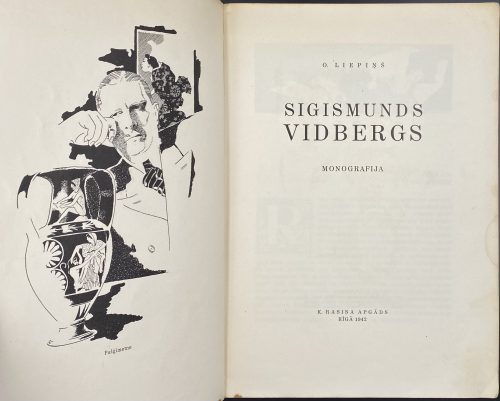 Publisher’s original wrappers, with VIDBERGS to front (bordered) and to spine, size 25 x 18 cm. Title page: O. LIEPIŅŠ | SIGISMUNDS | VIDBERGS | MONOGRAFIJA | K. RASIŅA APGĀDS | RIGĀ 1942 || Imprint: ATTĒLI MĀKSLINIEKA IZRAUDZĪTI UN SAKĀRTOTI (pictures selected and arranged by the artist) Pagination: [1-6] (incl. 1st blank leaf), 7-149 [150] [2] blank; 44 pages of text with in-text illustrations, pp. 47-149 – plates on odd pages, titles on even pages, 51 full-page illustrations. Circulation: 4,000 copies. Contributors: Liepiņš, Olģerts (Latvian, 1906 – 1983) – author. Sigismunds Vidbergs (Latvian-American, 1890 – 1970) – artist. Kārlis Rasiņš (Latvian, 1886 – 1974) – publisher.
Publisher’s original wrappers, with VIDBERGS to front (bordered) and to spine, size 25 x 18 cm. Title page: O. LIEPIŅŠ | SIGISMUNDS | VIDBERGS | MONOGRAFIJA | K. RASIŅA APGĀDS | RIGĀ 1942 || Imprint: ATTĒLI MĀKSLINIEKA IZRAUDZĪTI UN SAKĀRTOTI (pictures selected and arranged by the artist) Pagination: [1-6] (incl. 1st blank leaf), 7-149 [150] [2] blank; 44 pages of text with in-text illustrations, pp. 47-149 – plates on odd pages, titles on even pages, 51 full-page illustrations. Circulation: 4,000 copies. Contributors: Liepiņš, Olģerts (Latvian, 1906 – 1983) – author. Sigismunds Vidbergs (Latvian-American, 1890 – 1970) – artist. Kārlis Rasiņš (Latvian, 1886 – 1974) – publisher. -
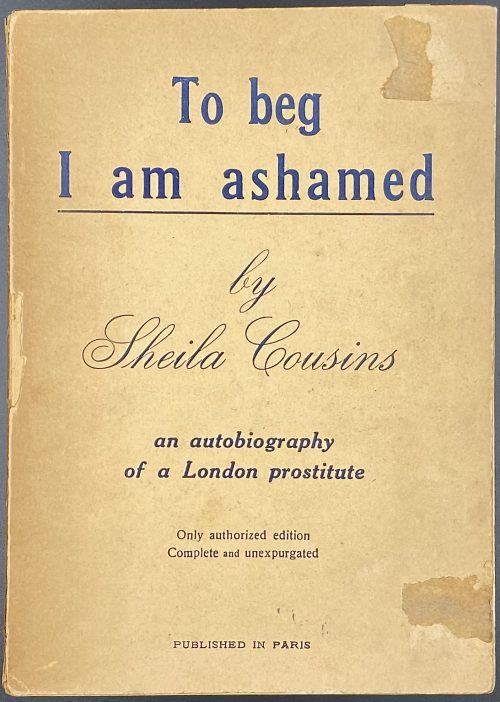 Cover: To beg | I am ashamed | by | Sheila Cousins | An autobiography | of a London prostitute | Only authorized edition | Complete and unexpurgated | PUBLISHED IN PARIS || Title page: SHEILA COUSINS | TO BEG | I AM ASHAMED || Pagination:[4] 1-252], total 256 pages. Binding: Original wrappers, black lettering to front, spine, and back: Price in France and Continent 75 Frs. | Price in America Two Dollars |—| OPERA PRESS || Size: 20.2 x 14.5 cm. Edition: Pirated edition. Contributors: Graham Greene (British, 1904 – 1991) – author. Ronald Matthews (British, 1903 – 1967) – author. Opera Press (Paris) – publisher.
Cover: To beg | I am ashamed | by | Sheila Cousins | An autobiography | of a London prostitute | Only authorized edition | Complete and unexpurgated | PUBLISHED IN PARIS || Title page: SHEILA COUSINS | TO BEG | I AM ASHAMED || Pagination:[4] 1-252], total 256 pages. Binding: Original wrappers, black lettering to front, spine, and back: Price in France and Continent 75 Frs. | Price in America Two Dollars |—| OPERA PRESS || Size: 20.2 x 14.5 cm. Edition: Pirated edition. Contributors: Graham Greene (British, 1904 – 1991) – author. Ronald Matthews (British, 1903 – 1967) – author. Opera Press (Paris) – publisher. -
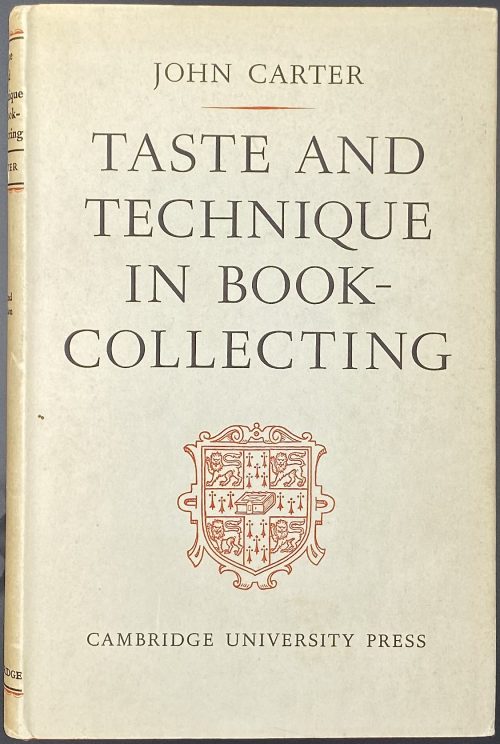 Title: TASTE & TECHNIQUE | IN | BOOK-COLLECTING | A study of recent developments in | Great Britain and the | United States | BY | JOHN CARTER | SANDERS READER IN BIBLIOGRAPHY | AND SOMETIME SCHOLAR OF | KING’S COLLEGE | {space} | {publisher’s device} | CAMBRIDGE | AT THE UNIVERSITY PRESS | 1949 || Half-title: TASTE & TECHNIQUE | IN | BOOK-COLLECTING | The Sanders Lectures in Bibliography | 1947 || Pagination: [i-vi] vii-x [xi] [xii blank], 1-201 [202 blank] [2] – advert. / blank, total 12+202+2=216 pages. Collation: 8vo; π6 1-128, 136, total 108 leaves. Binding: 22.5 x 15 cm, red cloth, gilt lettering to spine, lettered dust-jacket with armorial publisher’s device in red, price-clipped. Edition: 1st edition (1948), 2nd impression, corrected (1949). Contributors: Carter, John Waynflete (British, 1905 – 1975) – author. Cambridge University Press (Cambridge) – publisher. Brooke Crutchley – printer.
Title: TASTE & TECHNIQUE | IN | BOOK-COLLECTING | A study of recent developments in | Great Britain and the | United States | BY | JOHN CARTER | SANDERS READER IN BIBLIOGRAPHY | AND SOMETIME SCHOLAR OF | KING’S COLLEGE | {space} | {publisher’s device} | CAMBRIDGE | AT THE UNIVERSITY PRESS | 1949 || Half-title: TASTE & TECHNIQUE | IN | BOOK-COLLECTING | The Sanders Lectures in Bibliography | 1947 || Pagination: [i-vi] vii-x [xi] [xii blank], 1-201 [202 blank] [2] – advert. / blank, total 12+202+2=216 pages. Collation: 8vo; π6 1-128, 136, total 108 leaves. Binding: 22.5 x 15 cm, red cloth, gilt lettering to spine, lettered dust-jacket with armorial publisher’s device in red, price-clipped. Edition: 1st edition (1948), 2nd impression, corrected (1949). Contributors: Carter, John Waynflete (British, 1905 – 1975) – author. Cambridge University Press (Cambridge) – publisher. Brooke Crutchley – printer. -
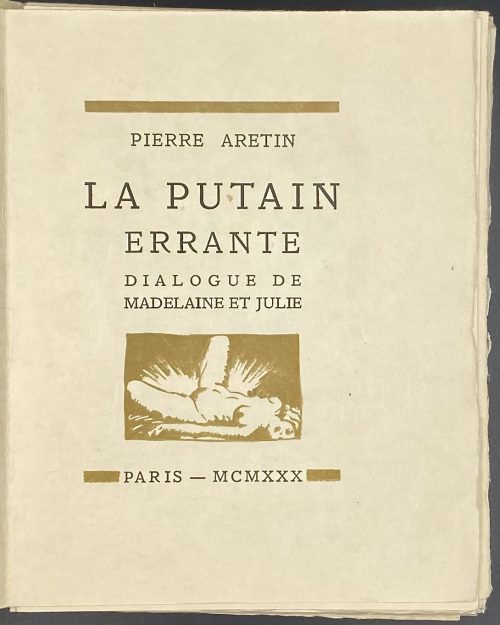 Title page (black lettering, gold elements of design): PIERRE ARETIN | LA PUTAIN | ERRANTE | DIALOGUE DE | MADELINE ET JULIE | {woodcut vignette} | PARIS — MCMXXX || Pagination: Red and gilt faux-marbled slipcase (19.5 x 15.5 cm), similar folder (18.7 x 15.1 cm), cream wove paper wrapper (18.5 x 14.7 cm) with gilt lettering “LA PUTAIN | ERRANTE”, with loosely inserted leaves printed on Japanese "mother-of-pearl" paper (japon nacré): [4] – blanks, [2] – h.t. / blank, [2] – t.p. / blank, 1-62, [2] – colophon / blank [4 blanks], gilt woodcut to p. 1; 76 pages total, plus 12 hand-coloured etchings (17.2 x 14.7 cm) by André Collot, extraneous to collation. Collation: 4to; π4, 1-84 χ2, 38 leaves total. Edition: 1st edition, limited to 150 copies, this is copy № 000009 (stamped in black ink). Catalogue raisonné: Dutel (1920-1970): № 2275, p. 333; Honesterotica. Contributors: Pietro Aretino (Italian, 1492 – 1556) – author (attributed). André Collot (French, 1897 – 1976) – artist.
Title page (black lettering, gold elements of design): PIERRE ARETIN | LA PUTAIN | ERRANTE | DIALOGUE DE | MADELINE ET JULIE | {woodcut vignette} | PARIS — MCMXXX || Pagination: Red and gilt faux-marbled slipcase (19.5 x 15.5 cm), similar folder (18.7 x 15.1 cm), cream wove paper wrapper (18.5 x 14.7 cm) with gilt lettering “LA PUTAIN | ERRANTE”, with loosely inserted leaves printed on Japanese "mother-of-pearl" paper (japon nacré): [4] – blanks, [2] – h.t. / blank, [2] – t.p. / blank, 1-62, [2] – colophon / blank [4 blanks], gilt woodcut to p. 1; 76 pages total, plus 12 hand-coloured etchings (17.2 x 14.7 cm) by André Collot, extraneous to collation. Collation: 4to; π4, 1-84 χ2, 38 leaves total. Edition: 1st edition, limited to 150 copies, this is copy № 000009 (stamped in black ink). Catalogue raisonné: Dutel (1920-1970): № 2275, p. 333; Honesterotica. Contributors: Pietro Aretino (Italian, 1492 – 1556) – author (attributed). André Collot (French, 1897 – 1976) – artist. -
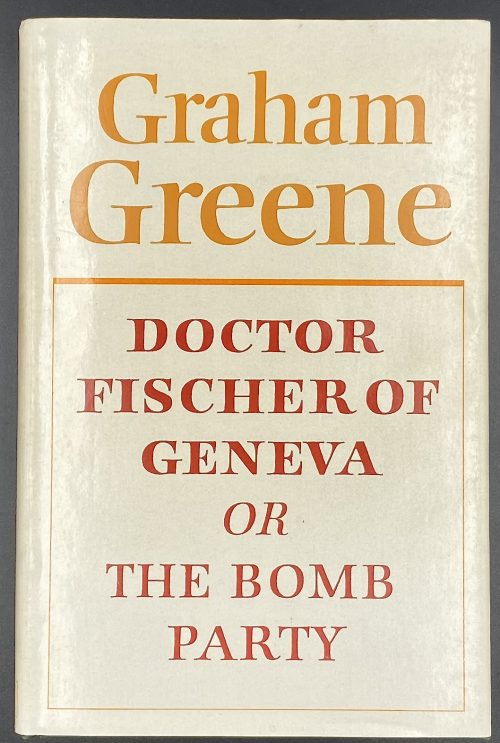 Title-page: GRAHAM GREENE | DOCTOR FISCHER | OF GENEVA | or | THE BOMB | PARTY | {publisher’s device} | THE BODLEY HEAD | LONDON SYDNEY | TORONTO || Green publisher’s cloth with gilt lettering to spine, cream dust jacket, lettered on front, back and spine, unclipped (£4.50 NET | IN U.K. ONLY), [1-8] 9-139 [140] + 2 blank leaves. Printed by Clowes Ltd. (Beccles). © Graham Greene 1980. Dust jacket design by Michael Harvey. Graham Greene (British, 1904 – 1991).
Title-page: GRAHAM GREENE | DOCTOR FISCHER | OF GENEVA | or | THE BOMB | PARTY | {publisher’s device} | THE BODLEY HEAD | LONDON SYDNEY | TORONTO || Green publisher’s cloth with gilt lettering to spine, cream dust jacket, lettered on front, back and spine, unclipped (£4.50 NET | IN U.K. ONLY), [1-8] 9-139 [140] + 2 blank leaves. Printed by Clowes Ltd. (Beccles). © Graham Greene 1980. Dust jacket design by Michael Harvey. Graham Greene (British, 1904 – 1991). -
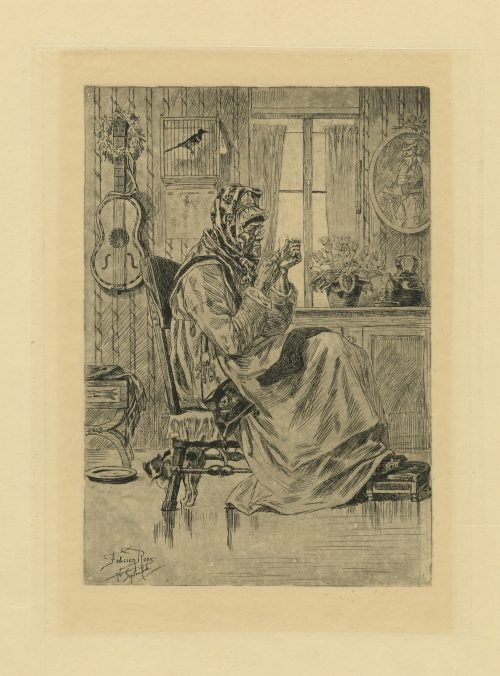
Etching on wove paper, depicting an old woman trying to thread a needle. Signed in plate: "Felicien Rops, 76 Septembre". Owner's stamp LvM on verso.
Dimensions: Paper: 51.9 x 35 cm; Plate: 27.5 x 21 cm; Image: 23.5 x 16 cm.
Catalogue raisonné: Arthur Hubschmid (1977): 358; Graphics irreverent and erotic (1968): 54.
-
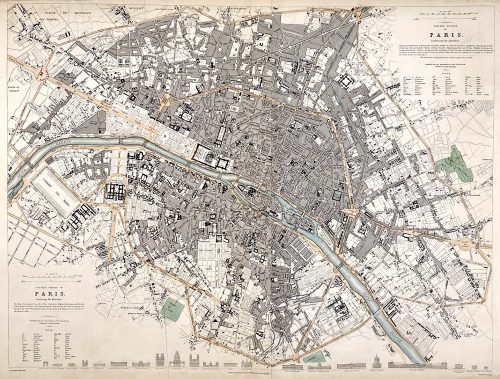 Top right: EASTERN DIVISION OF | PARIS. | Containing the Quartiers | {5 lines in italic} | Published under the Superintendence of the Society for the | Diffusion of Useful Knowledge || Bottom left: WESTERN DIVISION OF | PARIS. | Containing the Quartiers | {4 lines in italic} | Published under the Superintendence of the Society for the | Diffusion of Useful Knowledge || Under the frame: Drawn by W. B. Clarke, Archt. […] London: Published by Chapman and Hall, 186, Strand. April 1st, 1834. [...] Engraved by J. Shury || Dimensions: Sheet: 40.8 x 57 cm; Image: 38.7 x 52.5 cm. Contributors: William Barnard Clarke (British, 1806 – 1865) – artist. John Shury (fl. c. 1814-1844) – engraver. Chapman and Hall (London) – publisher. Society for the Diffusion of Useful Knowledge (SDUK) (British firm, 1826 – 1846).
Top right: EASTERN DIVISION OF | PARIS. | Containing the Quartiers | {5 lines in italic} | Published under the Superintendence of the Society for the | Diffusion of Useful Knowledge || Bottom left: WESTERN DIVISION OF | PARIS. | Containing the Quartiers | {4 lines in italic} | Published under the Superintendence of the Society for the | Diffusion of Useful Knowledge || Under the frame: Drawn by W. B. Clarke, Archt. […] London: Published by Chapman and Hall, 186, Strand. April 1st, 1834. [...] Engraved by J. Shury || Dimensions: Sheet: 40.8 x 57 cm; Image: 38.7 x 52.5 cm. Contributors: William Barnard Clarke (British, 1806 – 1865) – artist. John Shury (fl. c. 1814-1844) – engraver. Chapman and Hall (London) – publisher. Society for the Diffusion of Useful Knowledge (SDUK) (British firm, 1826 – 1846). -
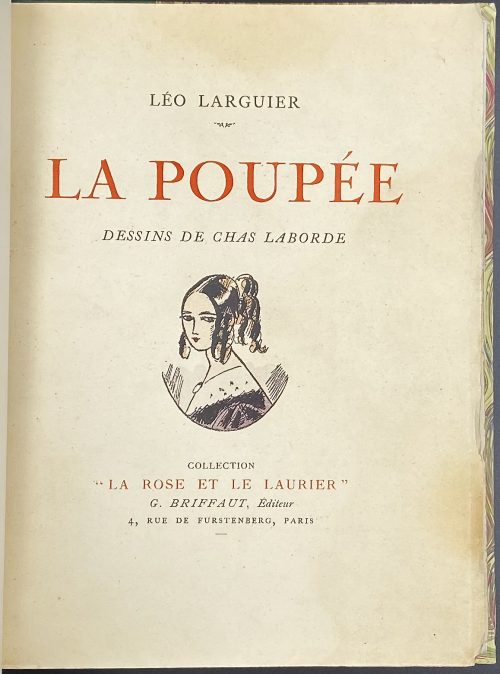 Description: owner’s quarter green morocco over marbled boards, 21.5 x 16.5 cm, collated 8vo, illustrated with numerous in-text and 5 full-page coloured etchings after drawings by Chas Laborde. Original publisher’s wrappers preserved, enriched with a set of 17 plates in black and white (bound in). Front wrapper (black and red): LÉO LARGUIER | LA POUPÉE | DESSINS DE CHAS LABORDE | {vignette} | COLLECTION | “LA ROSE ET LE LAURIER” | G. BRIFFAUT, Éditeur | 4, RUE DE FURSTENBERG, PARIS || Title-page: LÉO LARGUIER | — | LA POUPÉE | DESSINS DE | CHAS LABORDE | {vignette} | COLLECTION DE | “LA ROSE ET LE LAURIER” | G. BRIFFAUT, Éditeur | 4, RUE DE FURSTENBERG, PARIS (VIe) | M CM XXV || Collation: Three binder’s blanks, 1 front wrapper, 1 blank, 1 h.t./limit., 1 t.p., 1 epigraph, 1-68 74 (last blank), plates within collation, 1 back wrapper, three binder’s blanks, plus 17 leaves of b/w plates. Pagination: not counting wrappers, [6] (h.t., t.p., epigraph) 1-99 [100] [4], ils. Limitation: A print run of 770 copies on April 25, 1925, by Coulouma (Argenteuil) under the direction of H. Barthélemy , of which 10 copies on Japon Impérial (№ 1-10) + one drawing + one b/w suite, 10 copies on Japon Impérial (№ 11-20) + one drawing, 750 copies on Vélin (№ 21-770). This is copy № 1 (on Japon Impérial with b/w suite of plates but without the drawing). Contributors: Léo Larguier (French, 1878 – 1950) – author. Chas Laborde [Charles Laborde] (French, 1886 – 1941) – artist. Georges Briffaut (French, 1886 – 1973) – publisher.
Description: owner’s quarter green morocco over marbled boards, 21.5 x 16.5 cm, collated 8vo, illustrated with numerous in-text and 5 full-page coloured etchings after drawings by Chas Laborde. Original publisher’s wrappers preserved, enriched with a set of 17 plates in black and white (bound in). Front wrapper (black and red): LÉO LARGUIER | LA POUPÉE | DESSINS DE CHAS LABORDE | {vignette} | COLLECTION | “LA ROSE ET LE LAURIER” | G. BRIFFAUT, Éditeur | 4, RUE DE FURSTENBERG, PARIS || Title-page: LÉO LARGUIER | — | LA POUPÉE | DESSINS DE | CHAS LABORDE | {vignette} | COLLECTION DE | “LA ROSE ET LE LAURIER” | G. BRIFFAUT, Éditeur | 4, RUE DE FURSTENBERG, PARIS (VIe) | M CM XXV || Collation: Three binder’s blanks, 1 front wrapper, 1 blank, 1 h.t./limit., 1 t.p., 1 epigraph, 1-68 74 (last blank), plates within collation, 1 back wrapper, three binder’s blanks, plus 17 leaves of b/w plates. Pagination: not counting wrappers, [6] (h.t., t.p., epigraph) 1-99 [100] [4], ils. Limitation: A print run of 770 copies on April 25, 1925, by Coulouma (Argenteuil) under the direction of H. Barthélemy , of which 10 copies on Japon Impérial (№ 1-10) + one drawing + one b/w suite, 10 copies on Japon Impérial (№ 11-20) + one drawing, 750 copies on Vélin (№ 21-770). This is copy № 1 (on Japon Impérial with b/w suite of plates but without the drawing). Contributors: Léo Larguier (French, 1878 – 1950) – author. Chas Laborde [Charles Laborde] (French, 1886 – 1941) – artist. Georges Briffaut (French, 1886 – 1973) – publisher. -
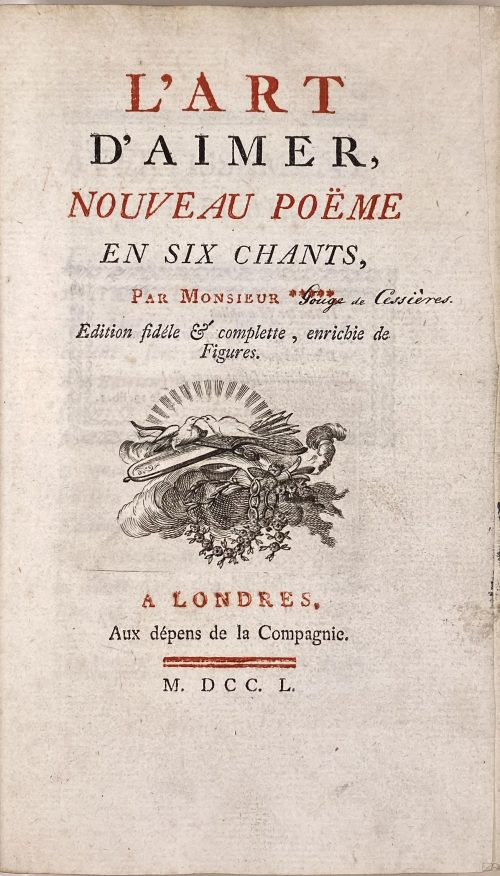 Description: 19th-century binding, 8vo,18.9 x 11.7 cm, in patterned quarter green shagreen over marbled boards, gilt elements and lettering to spine (reliure romantique), printed on laid paper, with tall "s", margins sprinkled blue. Title-page (red and black): L'ART | D'AIMER, | NOUVEAU POËME | EN SIX CHANTS, | Par Monsieur ***** Gouge de Cessières. | Edition fidéle & complette, enrichie de | Figures. | {vignette} | A LONDRES. | Aux dépens de la Compagnie. | = | M. DCC. L. || Includes: La Mort de Zulnï (pp. 175-190 ), Idée de l'Art d'aimer d'Ovide (pp. 191-244), and Lettre écrite à Monsieur *** de ******de l'Académie... (pp. 245-261). Collation: 8vo; a-b8, A-Q8 R3, lacking K2 (pp. 147/8); total 146 leaves (of 147) plus 8 engraved plates, unsigned, incl. frontispiece. Pagination: [i, ii] iii-xxxii, [1, 2] 3-261 [262 blank], lacking pp. 147/8 (K2), possibly containing Argument du chant VI; total 292 pages (of 294), ils. Catalogue raisonné: Cohen-DeRicci (under Ovid) 775, Lewine (under Ovid) 398. The artist and engravers of this edition are unknown. "Another edition, Londres (Paris), 1760, with frontispiece after Eisen by Martinet, and 6 plates after Martinet". Contributors: François-Étienne Gouge de Cessières (French, 1724 – 1782) – author. Ovid [Publius Ovidius Naso] (Roman, 43 B.C. – A.D. 17) – author. Aux dépens de la Compagnie (1685 – 1780) (Amsterdam) – publisher.
Description: 19th-century binding, 8vo,18.9 x 11.7 cm, in patterned quarter green shagreen over marbled boards, gilt elements and lettering to spine (reliure romantique), printed on laid paper, with tall "s", margins sprinkled blue. Title-page (red and black): L'ART | D'AIMER, | NOUVEAU POËME | EN SIX CHANTS, | Par Monsieur ***** Gouge de Cessières. | Edition fidéle & complette, enrichie de | Figures. | {vignette} | A LONDRES. | Aux dépens de la Compagnie. | = | M. DCC. L. || Includes: La Mort de Zulnï (pp. 175-190 ), Idée de l'Art d'aimer d'Ovide (pp. 191-244), and Lettre écrite à Monsieur *** de ******de l'Académie... (pp. 245-261). Collation: 8vo; a-b8, A-Q8 R3, lacking K2 (pp. 147/8); total 146 leaves (of 147) plus 8 engraved plates, unsigned, incl. frontispiece. Pagination: [i, ii] iii-xxxii, [1, 2] 3-261 [262 blank], lacking pp. 147/8 (K2), possibly containing Argument du chant VI; total 292 pages (of 294), ils. Catalogue raisonné: Cohen-DeRicci (under Ovid) 775, Lewine (under Ovid) 398. The artist and engravers of this edition are unknown. "Another edition, Londres (Paris), 1760, with frontispiece after Eisen by Martinet, and 6 plates after Martinet". Contributors: François-Étienne Gouge de Cessières (French, 1724 – 1782) – author. Ovid [Publius Ovidius Naso] (Roman, 43 B.C. – A.D. 17) – author. Aux dépens de la Compagnie (1685 – 1780) (Amsterdam) – publisher. -
 Artist (character): Utagawa Kunisada [歌川 国貞] a.k.a. Utagawa Toyokuni III [三代歌川豊国] (Japanese, 1786 – 1865). Artist (landscape): Utagawa Kunihisa II [歌川国久] (Japanese, 1832 – 1981), a.k.a. Katsuda Hisatarō, Ichiunsai, Ritchōrō, Toyonobu, Yōryūsai, Yōsai. Block carver: Matsushima Masakichi (Japanese, fl. c. 1847-65); seal: [松嶋彫政] – Matsushima Hori Masa (Frieze, 2009: 142) Publisher: Iseya Magobei [伊勢屋孫兵衛] (Japanese, fl. c. 1794 – 1868). Signed: By the brush of Toyokuni at the age of 78 [七十八歳豊国筆] (Nanajūhachi-sai Toyokuni hitsu) – in a red toshidama cartouche (left). Signed: Landscape by Kunihisa [景色 国久画] (Keshiki Kunihisa ga) (right). Actor: Nakamura Shikan IV [中村芝翫] (Japanese, 1831 – 1899); other names: Nakamura Fukusuke I, Nakamura Masanosuke I, Nakamura Komasaburō, Nakamura Tamatarō I. Combined date seal and kiwame censor seal: [亥極] – Bunkyū 3 (1863) Tasogare (literally, twilight] [たそがれ] is a character in the novel Rustic Genji and a role in various kabuki plays. Fake Murasaki’s Rustic Genji [偐紫田舎源氏] (Nise Murasaki inaka Genji) is a literary parody written by Ryutei Tanehiko [柳亭種彦] (Japanese, 1783 – 1842). According to Horst Graebner, this must be a mitate print because there was no known performance of this play in 1863.
Artist (character): Utagawa Kunisada [歌川 国貞] a.k.a. Utagawa Toyokuni III [三代歌川豊国] (Japanese, 1786 – 1865). Artist (landscape): Utagawa Kunihisa II [歌川国久] (Japanese, 1832 – 1981), a.k.a. Katsuda Hisatarō, Ichiunsai, Ritchōrō, Toyonobu, Yōryūsai, Yōsai. Block carver: Matsushima Masakichi (Japanese, fl. c. 1847-65); seal: [松嶋彫政] – Matsushima Hori Masa (Frieze, 2009: 142) Publisher: Iseya Magobei [伊勢屋孫兵衛] (Japanese, fl. c. 1794 – 1868). Signed: By the brush of Toyokuni at the age of 78 [七十八歳豊国筆] (Nanajūhachi-sai Toyokuni hitsu) – in a red toshidama cartouche (left). Signed: Landscape by Kunihisa [景色 国久画] (Keshiki Kunihisa ga) (right). Actor: Nakamura Shikan IV [中村芝翫] (Japanese, 1831 – 1899); other names: Nakamura Fukusuke I, Nakamura Masanosuke I, Nakamura Komasaburō, Nakamura Tamatarō I. Combined date seal and kiwame censor seal: [亥極] – Bunkyū 3 (1863) Tasogare (literally, twilight] [たそがれ] is a character in the novel Rustic Genji and a role in various kabuki plays. Fake Murasaki’s Rustic Genji [偐紫田舎源氏] (Nise Murasaki inaka Genji) is a literary parody written by Ryutei Tanehiko [柳亭種彦] (Japanese, 1783 – 1842). According to Horst Graebner, this must be a mitate print because there was no known performance of this play in 1863. -
 Artist: Utagawa Kunisada [歌川 国貞] a.k.a. Utagawa Toyokuni III [三代歌川豊国] (Japanese, 1786 – 1865). Signed: Kōchō(rō) Kunisada ga (香蝶国貞画) in a red double-gourd cartouche. Publisher: Surugaya Sakujirō [駿河屋作次郎] (Japanese, fl. c. 1844 – 1865); Marks 06-005 | 501a. Single nanushi censor seal: Muramatsu (1843-6). The date is attributed to c. 1844. Title: Narihira [なり平]. Ariwara no Narihira [在原 業平] (Japanese, 825 – 880) – one of the Six Immortal Poets – The Rokkasen [六歌仙]. Series: A parody of six immortal poets [見立六花撰] (Mitate Rokkasen). Media: Untrimmed fan print (uchiwa-e), 227 x 293 mm, depicting a beautiful woman with a bow and arrows in her left hand. Series: Mitate Rokkasen [見立六花撰] – is sometimes interpreted as "A parody of six immortal poets" or "A comparison of six select flowers". [LIB-1212.2017] Robert Schaap. Kunisada: Imaging, drama and beauty. — Leiden: Hotei Publishing, 2016; pl. 28, p. 58. This is another fan print with another immortal poet, Bun'ya no Yasuhide [文屋 康秀] (Japanese, -d. 885?), from the same series, provided in the book:With special thanks to Horst Graebner for help with the description and date attribution: "The print can be dated to 1844: censor seal is Muramatsu (Muramatsu Genroku); he acted in 7/1844 and 4/1845 (and also later) as censor but Kunisada changed his name to Kunisada early in 1844."
Artist: Utagawa Kunisada [歌川 国貞] a.k.a. Utagawa Toyokuni III [三代歌川豊国] (Japanese, 1786 – 1865). Signed: Kōchō(rō) Kunisada ga (香蝶国貞画) in a red double-gourd cartouche. Publisher: Surugaya Sakujirō [駿河屋作次郎] (Japanese, fl. c. 1844 – 1865); Marks 06-005 | 501a. Single nanushi censor seal: Muramatsu (1843-6). The date is attributed to c. 1844. Title: Narihira [なり平]. Ariwara no Narihira [在原 業平] (Japanese, 825 – 880) – one of the Six Immortal Poets – The Rokkasen [六歌仙]. Series: A parody of six immortal poets [見立六花撰] (Mitate Rokkasen). Media: Untrimmed fan print (uchiwa-e), 227 x 293 mm, depicting a beautiful woman with a bow and arrows in her left hand. Series: Mitate Rokkasen [見立六花撰] – is sometimes interpreted as "A parody of six immortal poets" or "A comparison of six select flowers". [LIB-1212.2017] Robert Schaap. Kunisada: Imaging, drama and beauty. — Leiden: Hotei Publishing, 2016; pl. 28, p. 58. This is another fan print with another immortal poet, Bun'ya no Yasuhide [文屋 康秀] (Japanese, -d. 885?), from the same series, provided in the book:With special thanks to Horst Graebner for help with the description and date attribution: "The print can be dated to 1844: censor seal is Muramatsu (Muramatsu Genroku); he acted in 7/1844 and 4/1845 (and also later) as censor but Kunisada changed his name to Kunisada early in 1844."
Robert Schaap, 2016.
-
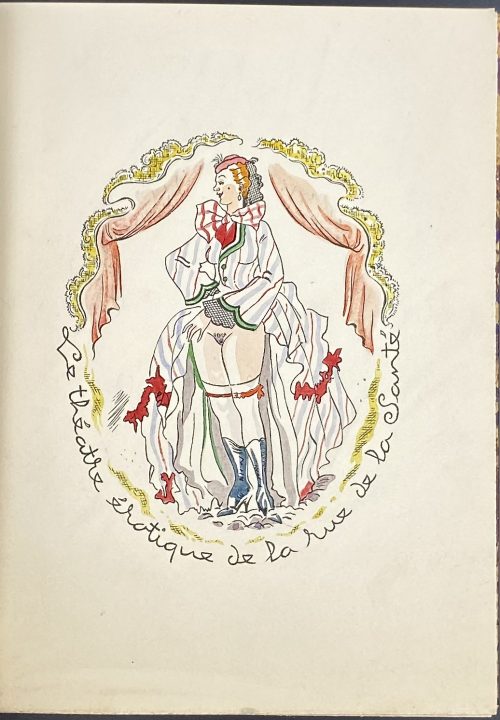 Description: Hardcover small 4to, 20.3 x 15.8 cm, contemporary binding, quarter carrot morocco with raised bands over marbled boards, marbled endpapers, original wrappers preserved, gilt lettering to spine. Content: Scapin Maquereau, drame en un acte par M. Albert Glatigny; La grisette et l’étudiant, pièce en un acte par M. Henry Monnier; Le bout de l’an de la noce, parodie du bout de l’an de l’amour de M. Théodore Barrière par MM. Lemercier de Neuville et J. du Boys; Un caprice par Lemercier de Neuville; Les jeux de l’amour et du bazar, comédie de mœurs en un acte par Lemercier de Neuville. Title-page: LE THÉATRE ÉROTIQUE | DE LA RUE DE LA SANTE | {vignette} | PARIS | — | 1932 || Collation: 3 blanks, original front wrapper with black lettering «LE THÉATRE ÉROTIQUE | DE LA RUE DE LA SANTE», [1]4 (2 blanks, frontis., h.t. / limitation), [2]4 (t.p., f.t.p., 2 leaves of text), 3-184 (incl. 2 blanks), original back wrapper, original spine, 3 blanks; 5 full-page illustrations within collation, 3 original watercolours extraneous to collation bound in between 11 and 12 blank leaves. Pagination: [4] [1-8] 9-135 [136] [4], ils. Limitation: 20 copies on Japon and 250 copies on Vélin, this is copy № 201. Edition: 1st edition thus, illustrated with 20 coloured photogravures, 5 of them full-page after Feodor Rojankovsky [Rojan], enriched with 3 full-page original watercolours by him. Catalogue raisonné: Dutel (1920-1970): 2498, p. 385; Nordmann/Christie’s (2) 515, p. 251 Contributors: Feodor Rojankovsky [Rojan, Фёдор Степанович Рожанковский] (Russian-American, 1891 – 1970) – artist. Joseph Albert Alexandre Glatigny (French, 1839 – 1873) – author. Henry-Bonaventure Monnier (French, 1799 – 1877) – author. Théodore Barrière (French, 1823 – 1877) – author. Louis Lemercier de Neuville [La Haudussière, Louis Lemercier] (French, 1830 – 1918) – author. Jean Charles Duboys [Du Boys] (French, 1836 – 1873) – author. Original watercolours:
Description: Hardcover small 4to, 20.3 x 15.8 cm, contemporary binding, quarter carrot morocco with raised bands over marbled boards, marbled endpapers, original wrappers preserved, gilt lettering to spine. Content: Scapin Maquereau, drame en un acte par M. Albert Glatigny; La grisette et l’étudiant, pièce en un acte par M. Henry Monnier; Le bout de l’an de la noce, parodie du bout de l’an de l’amour de M. Théodore Barrière par MM. Lemercier de Neuville et J. du Boys; Un caprice par Lemercier de Neuville; Les jeux de l’amour et du bazar, comédie de mœurs en un acte par Lemercier de Neuville. Title-page: LE THÉATRE ÉROTIQUE | DE LA RUE DE LA SANTE | {vignette} | PARIS | — | 1932 || Collation: 3 blanks, original front wrapper with black lettering «LE THÉATRE ÉROTIQUE | DE LA RUE DE LA SANTE», [1]4 (2 blanks, frontis., h.t. / limitation), [2]4 (t.p., f.t.p., 2 leaves of text), 3-184 (incl. 2 blanks), original back wrapper, original spine, 3 blanks; 5 full-page illustrations within collation, 3 original watercolours extraneous to collation bound in between 11 and 12 blank leaves. Pagination: [4] [1-8] 9-135 [136] [4], ils. Limitation: 20 copies on Japon and 250 copies on Vélin, this is copy № 201. Edition: 1st edition thus, illustrated with 20 coloured photogravures, 5 of them full-page after Feodor Rojankovsky [Rojan], enriched with 3 full-page original watercolours by him. Catalogue raisonné: Dutel (1920-1970): 2498, p. 385; Nordmann/Christie’s (2) 515, p. 251 Contributors: Feodor Rojankovsky [Rojan, Фёдор Степанович Рожанковский] (Russian-American, 1891 – 1970) – artist. Joseph Albert Alexandre Glatigny (French, 1839 – 1873) – author. Henry-Bonaventure Monnier (French, 1799 – 1877) – author. Théodore Barrière (French, 1823 – 1877) – author. Louis Lemercier de Neuville [La Haudussière, Louis Lemercier] (French, 1830 – 1918) – author. Jean Charles Duboys [Du Boys] (French, 1836 – 1873) – author. Original watercolours: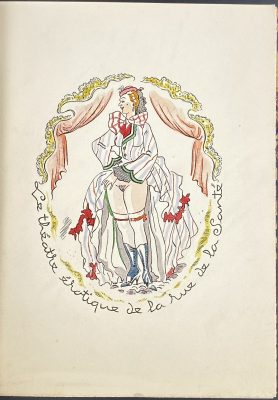

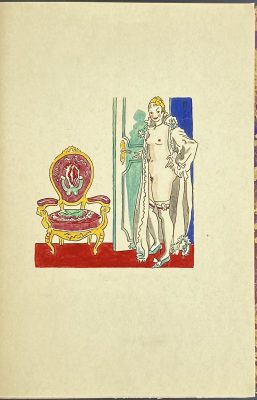
-

Small iron tsuba for a dagger (tantō), of quatrefoil form (mokkō-gata), with raised rim (mimi), decorated with flat brass inlay (hira-zōgan) to form an abstract design alluding to the mushroom of immortality (reishi). Opening (hitsu-ana) to the left of nakaga-ana probably cut later and fitted with shakudo sekigane. Maker's signature on seppa-dai: Koike Naomasa (小池 直正).
Momoyama period: End of the 16th - beginning of the 17th century. Dimensions: Height 53.7 mm; Width: 45.5 mm; Thickness at centre: 3.5 mm; at rim: 4.9 mm. Other examples of signed Koike Naomasa work in this collection: TSU-0346. Reference: The closest example in literature is in Compton Collection (II): №11 with the description: “A Koike School tsuba, Edo period (circa 1625), signed Koike Yoshiro. Sheet-brass flush inlay of cloud forms and wire inlay creating the same shape. Koike Yoshiro Naomasa worked from the Keicho to the Genna periods (1596-1623). He arrived in Kyoto from Kaga.” [Japanese Swords and Sword Fittings from the Collection of Dr. Walter Ames Compton (Part II) / Sebastian Izzard, Yoshinori Munemura. — Christie's, New York, October 22, 1992]. See: Yoshirō tsuba.
-
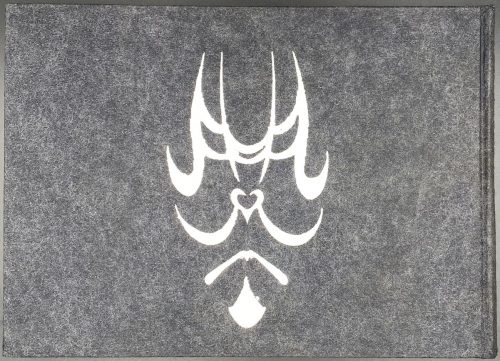 Book title: Kabuki fan-prints from Edo: Genroku to Enkyō periods (1688-1748) [江戸歌舞伎団扇絵] (Edo kabuki uchiwa-e: Genroku - Enkyō hen). Author: Shigeo Miyao [宮尾しげを] (Japanese, 1902 – 1982). Comments by: Sutezō Kimura [木村仙集] (Japanese, 20th century). Publisher: Inoue Shobō [井上書房] (Tokyo). Oblong volume bound in black washi paper with silver kabuki face design to front and silver lettering to spine and silver publisher’s name to back; three-colour title, folding frontispiece, second frontispiece, pp.: [6] foreword, contents, [2] f.t.p./blank, 3-134 [2], 43 full-page black & white illustrations, colophon slip pasted, bookstore label to back pastedown, in a pink slipcase with black lettering. Primitive fan prints from the Kaga collection, from 1691 to 1747. Edition: 1st edition, limited to 500 copies.
Book title: Kabuki fan-prints from Edo: Genroku to Enkyō periods (1688-1748) [江戸歌舞伎団扇絵] (Edo kabuki uchiwa-e: Genroku - Enkyō hen). Author: Shigeo Miyao [宮尾しげを] (Japanese, 1902 – 1982). Comments by: Sutezō Kimura [木村仙集] (Japanese, 20th century). Publisher: Inoue Shobō [井上書房] (Tokyo). Oblong volume bound in black washi paper with silver kabuki face design to front and silver lettering to spine and silver publisher’s name to back; three-colour title, folding frontispiece, second frontispiece, pp.: [6] foreword, contents, [2] f.t.p./blank, 3-134 [2], 43 full-page black & white illustrations, colophon slip pasted, bookstore label to back pastedown, in a pink slipcase with black lettering. Primitive fan prints from the Kaga collection, from 1691 to 1747. Edition: 1st edition, limited to 500 copies. -
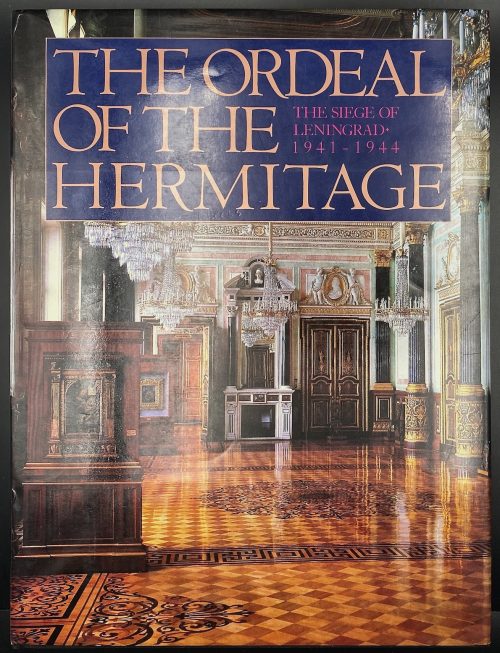 © Aurora Art Publishers: ISBN 0-8109-1406-9. Printed and bound in Finland. A pictorial album about the history and collections of The Hermitage museum in St. Petersburg during World War II. Title-page: in frame: THE ORDEAL | OF THE | THE SIEGE OF | LENINGRAD• | 1941 – 1944 | HERMITAGE; under the frame: Text by Sergei Varshavsky and Boris Rest | — | AURORA ART PUBLISHERS, LENINGRAD• | HARRY N. ABRAMS, INC., PUBLISHERS, NEW YORK || Description: Illustrated album in hardcover, 33 x 25 cm, bound in black cloth with gilt and purple lettering to spine, brown endpapers, pictorial dust jacket; pp.: [1-6] 7-270 [34], total 304 pages with b/w and colour illustrations. Text: Sergei Petrovich Varshavsky [Сергей Петрович Варшавский] (Jewish-Russian, 1906 – 1980); B. Rest [Б. Рест; Юлий Исаакович Шапиро] (Jewish-Russian, fl. 1940 – 1980). Preface: Boris Piotrovsky [Борис Борисович Пиотровский] (Russian, 1908 – 1990). Translated by Arthur Shkarovsky-Rafeé. Layout by Liubov Rakhmilevich. Photography by Viktor Savik and Leonid Bogdanov. A twin edition to [LIB-3043.2022] S. Varshavsky, B. Rest. Saved for humanity: the Hermitage during the siege of Leningrad, 1941-1944. — Leningrad: Aurora Art Publishers, 1985 and the Russian edition [LIB-3044.2022] C. Варшавский, Б. Рест. Подвиг Эрмитажа, 1941-1944 / Альбом. — Ленинград: Издательство «Аврора», 1987. The text extracted from [LIB-3035.2022] С. Варшавский, Б. Рест. Подвиг Эрмитажа: Государственный Эрмитаж в годы Великой отечественной войны. — М.-Л.: Советский художник, 1965.
© Aurora Art Publishers: ISBN 0-8109-1406-9. Printed and bound in Finland. A pictorial album about the history and collections of The Hermitage museum in St. Petersburg during World War II. Title-page: in frame: THE ORDEAL | OF THE | THE SIEGE OF | LENINGRAD• | 1941 – 1944 | HERMITAGE; under the frame: Text by Sergei Varshavsky and Boris Rest | — | AURORA ART PUBLISHERS, LENINGRAD• | HARRY N. ABRAMS, INC., PUBLISHERS, NEW YORK || Description: Illustrated album in hardcover, 33 x 25 cm, bound in black cloth with gilt and purple lettering to spine, brown endpapers, pictorial dust jacket; pp.: [1-6] 7-270 [34], total 304 pages with b/w and colour illustrations. Text: Sergei Petrovich Varshavsky [Сергей Петрович Варшавский] (Jewish-Russian, 1906 – 1980); B. Rest [Б. Рест; Юлий Исаакович Шапиро] (Jewish-Russian, fl. 1940 – 1980). Preface: Boris Piotrovsky [Борис Борисович Пиотровский] (Russian, 1908 – 1990). Translated by Arthur Shkarovsky-Rafeé. Layout by Liubov Rakhmilevich. Photography by Viktor Savik and Leonid Bogdanov. A twin edition to [LIB-3043.2022] S. Varshavsky, B. Rest. Saved for humanity: the Hermitage during the siege of Leningrad, 1941-1944. — Leningrad: Aurora Art Publishers, 1985 and the Russian edition [LIB-3044.2022] C. Варшавский, Б. Рест. Подвиг Эрмитажа, 1941-1944 / Альбом. — Ленинград: Издательство «Аврора», 1987. The text extracted from [LIB-3035.2022] С. Варшавский, Б. Рест. Подвиг Эрмитажа: Государственный Эрмитаж в годы Великой отечественной войны. — М.-Л.: Советский художник, 1965. -
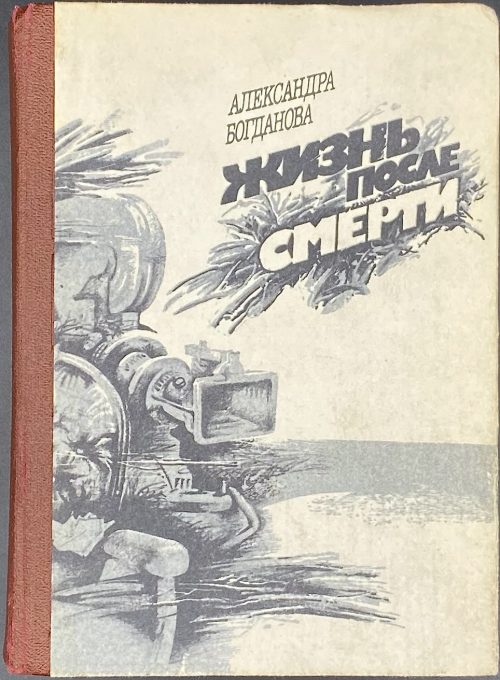 Hardcover, 17.2 x 12.5 cm, brown cloth-backed pictorial paper boards, lettering to front and spine, pictorial endpapers, pp.: [1-4] 5-430 [2], total 432 pages; collated in-16mo: [1]-1216 138 1416, total 216 leaves. Print run: 65,000 copies. A real history-based fiction about doctor Nikolai Sudzilovsky [Nicholas Russel] (Belarusian, 1850 – 1930). Title-page (pictorial): АЛЕКСАНДРА | БОГДАНОВА | ЖИЗНЬ | ПОСЛЕ | СМЕРТИ | Роман || Imprint: Рецензент доктор филилогических наук Н. Г. Жулинский. Редактор В. А. Лигостов. Богданова А. И. Жизнь после смерти: Роман. — К.: Рад. письменник, 1990. — 431 с. ISBN 5-333-00201-0. Colophon: Литературно-художественное издание. БОГДАНОВА АЛЕКСАНДРА ИВАНОВНА | Жизнь после смерти. Роман. Киев, издательство «Радяньский пысьмэннык». Author: Богданова, Александра Ивановна (b. c. 1950).
Hardcover, 17.2 x 12.5 cm, brown cloth-backed pictorial paper boards, lettering to front and spine, pictorial endpapers, pp.: [1-4] 5-430 [2], total 432 pages; collated in-16mo: [1]-1216 138 1416, total 216 leaves. Print run: 65,000 copies. A real history-based fiction about doctor Nikolai Sudzilovsky [Nicholas Russel] (Belarusian, 1850 – 1930). Title-page (pictorial): АЛЕКСАНДРА | БОГДАНОВА | ЖИЗНЬ | ПОСЛЕ | СМЕРТИ | Роман || Imprint: Рецензент доктор филилогических наук Н. Г. Жулинский. Редактор В. А. Лигостов. Богданова А. И. Жизнь после смерти: Роман. — К.: Рад. письменник, 1990. — 431 с. ISBN 5-333-00201-0. Colophon: Литературно-художественное издание. БОГДАНОВА АЛЕКСАНДРА ИВАНОВНА | Жизнь после смерти. Роман. Киев, издательство «Радяньский пысьмэннык». Author: Богданова, Александра Ивановна (b. c. 1950). -
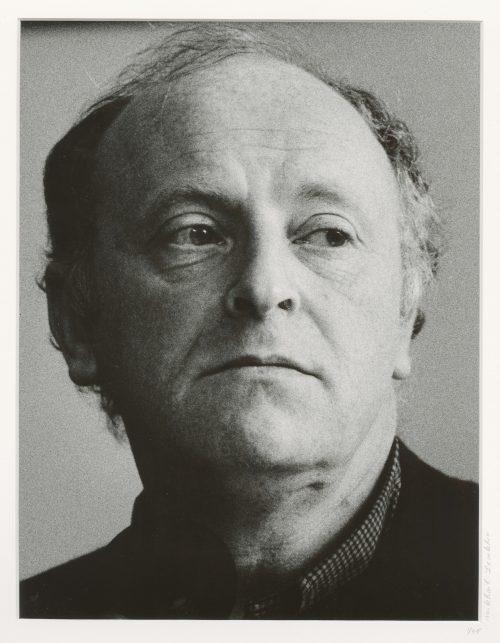 Photographic portrait of poet Joseph Brodsky, head and shoulder, turned slightly right, looking to the right. Pencil-signed on the mat: 1/45 • Mikhail Lemkhin; same inscription on the back of the print, and ink stamp ©Mikhail Lemkhin. Sitter: Joseph Brodsky [Иосиф Александрович Бродский ] (Russian-American-Jewish, 1940 – 1996). Size: mat: 51 x 40.5 cm; window: 34.5 x 27 cm; print: 35 x 28 cm.
Photographic portrait of poet Joseph Brodsky, head and shoulder, turned slightly right, looking to the right. Pencil-signed on the mat: 1/45 • Mikhail Lemkhin; same inscription on the back of the print, and ink stamp ©Mikhail Lemkhin. Sitter: Joseph Brodsky [Иосиф Александрович Бродский ] (Russian-American-Jewish, 1940 – 1996). Size: mat: 51 x 40.5 cm; window: 34.5 x 27 cm; print: 35 x 28 cm.


